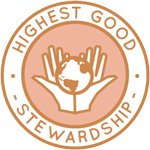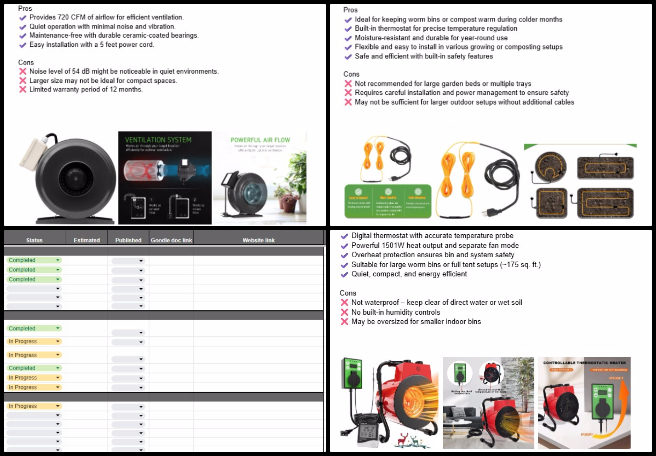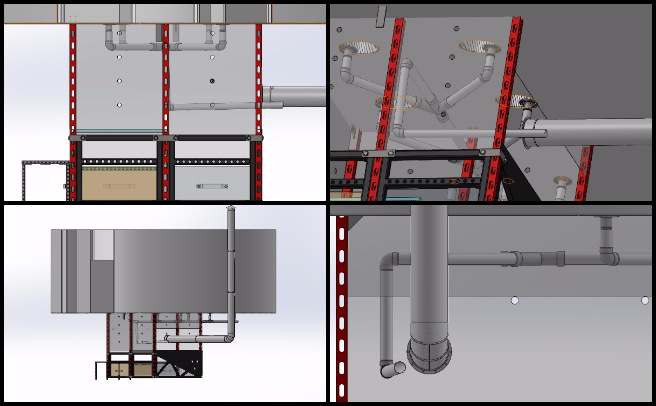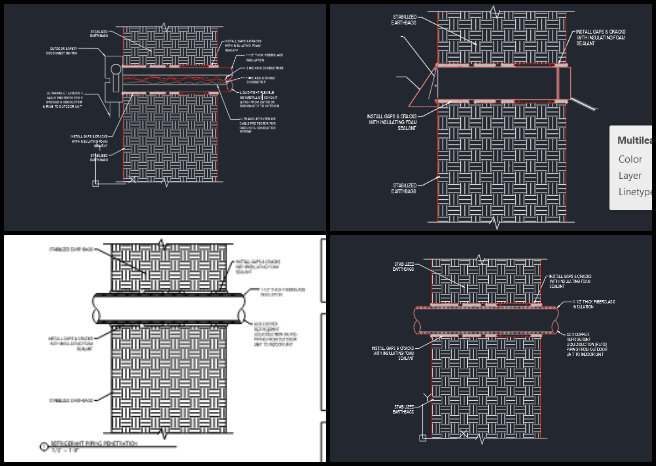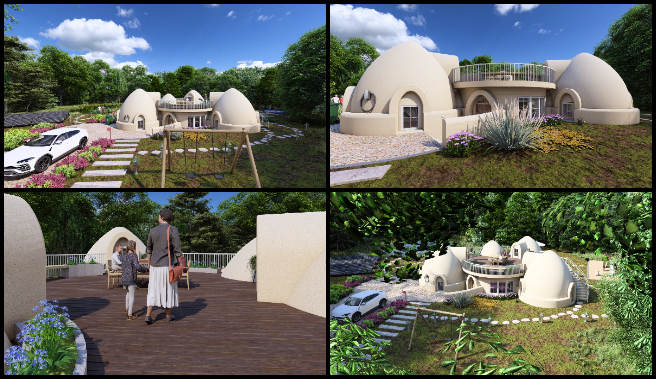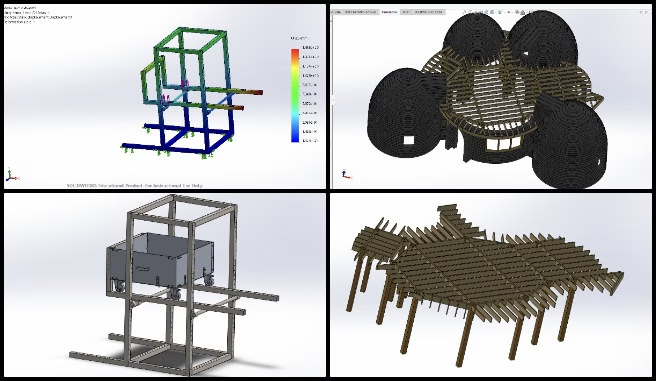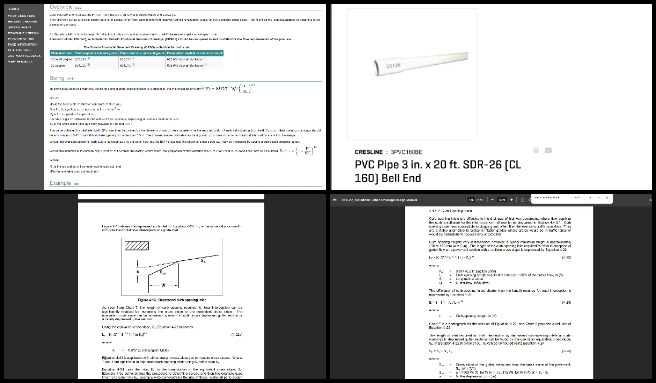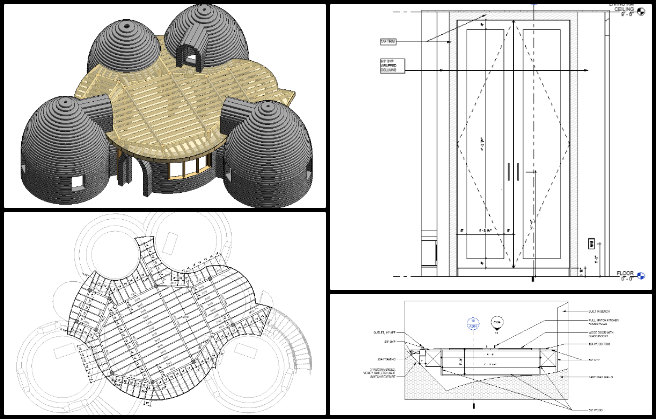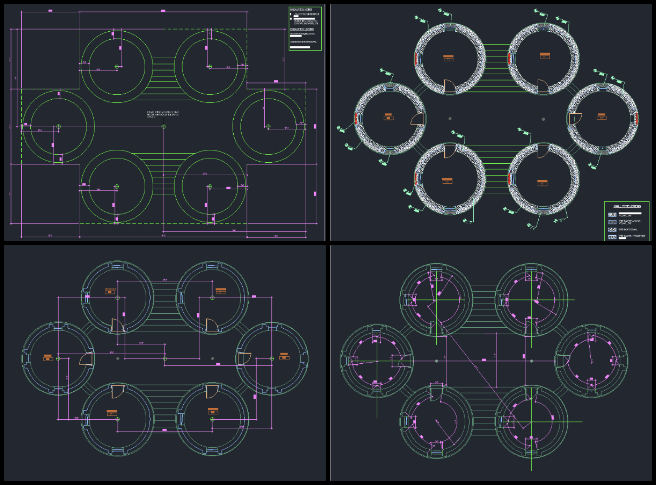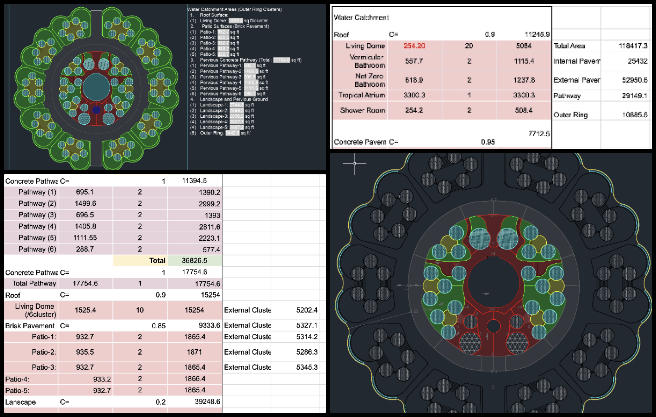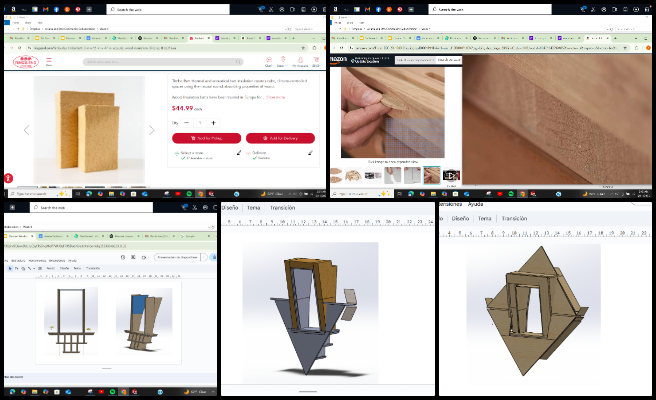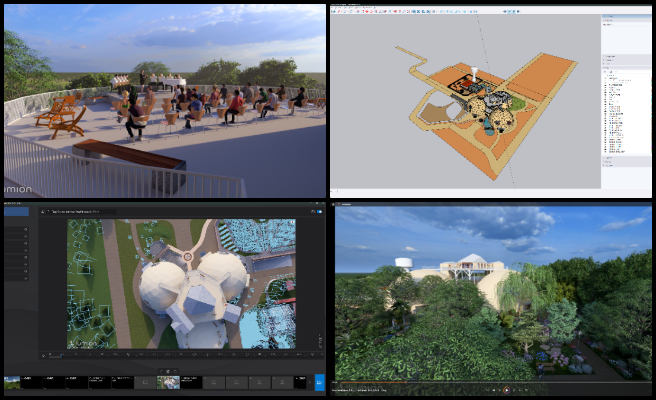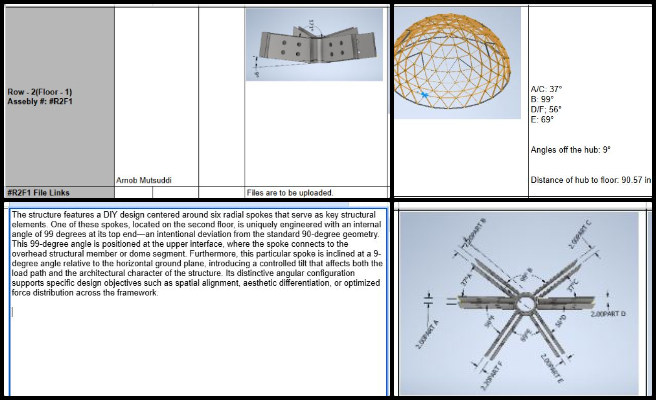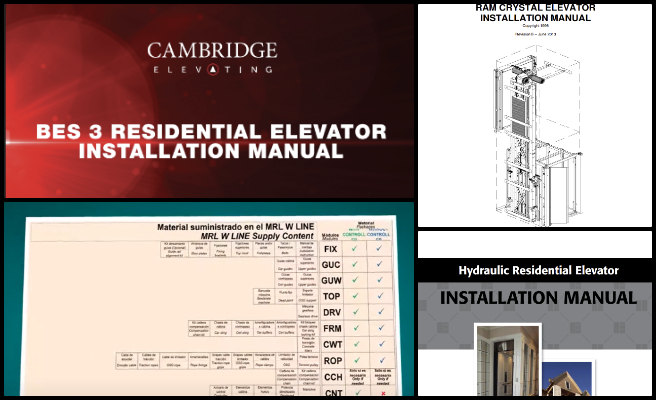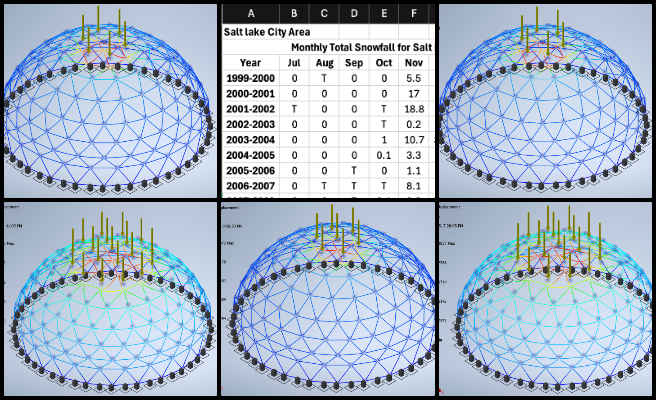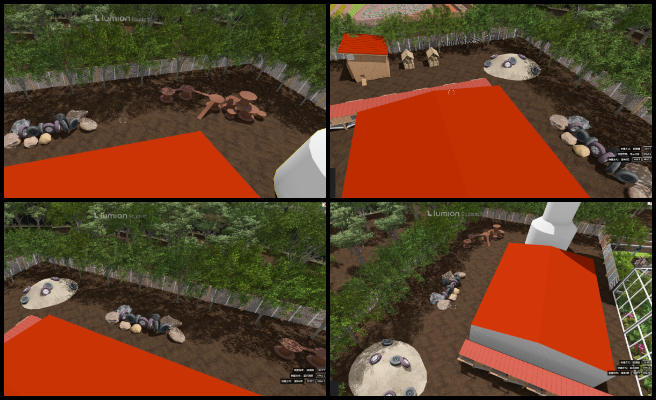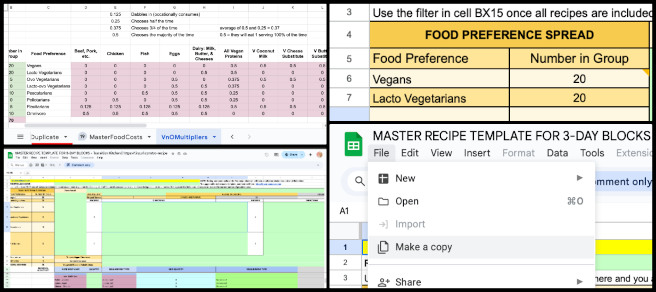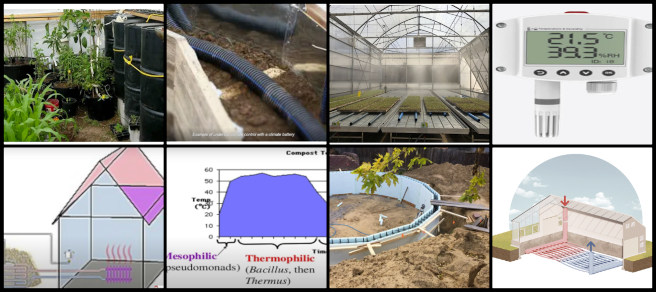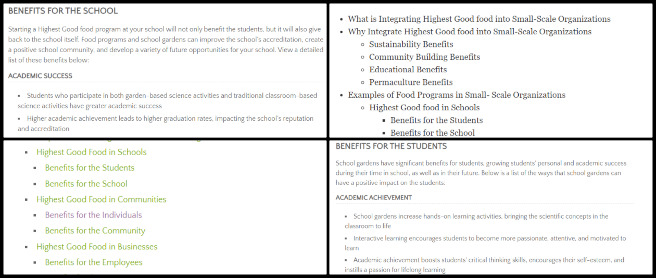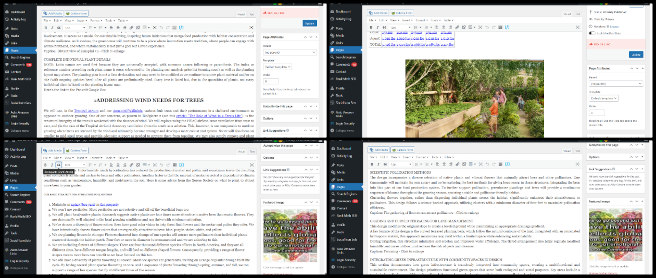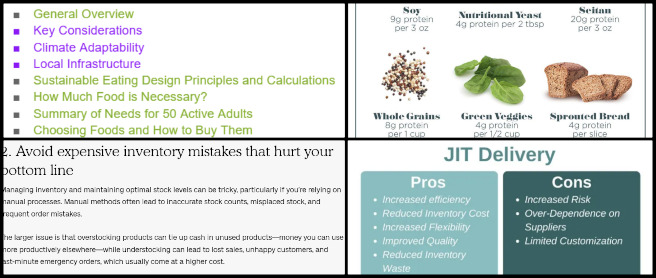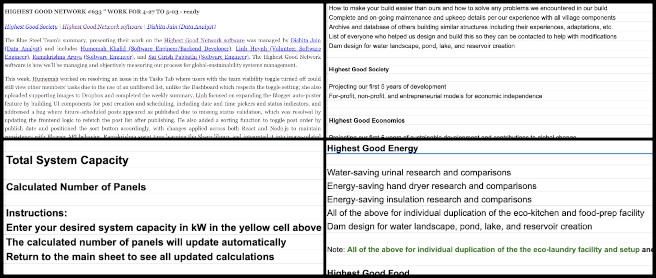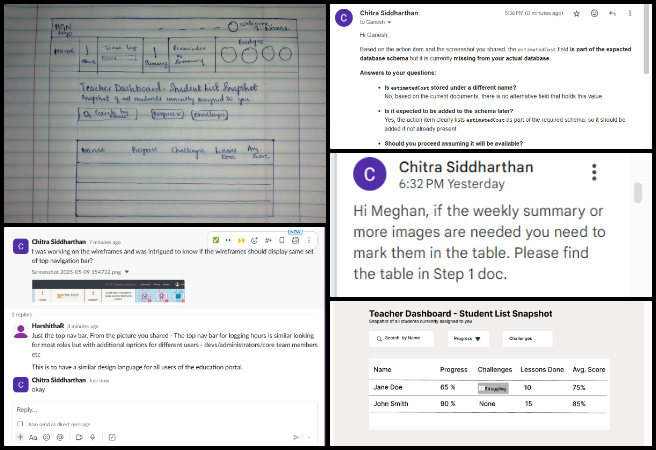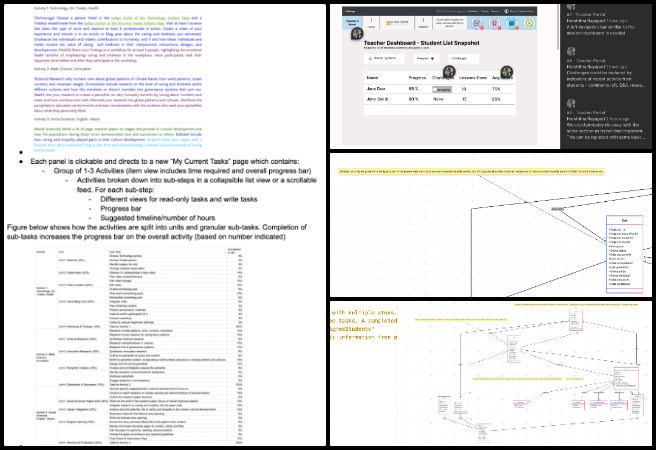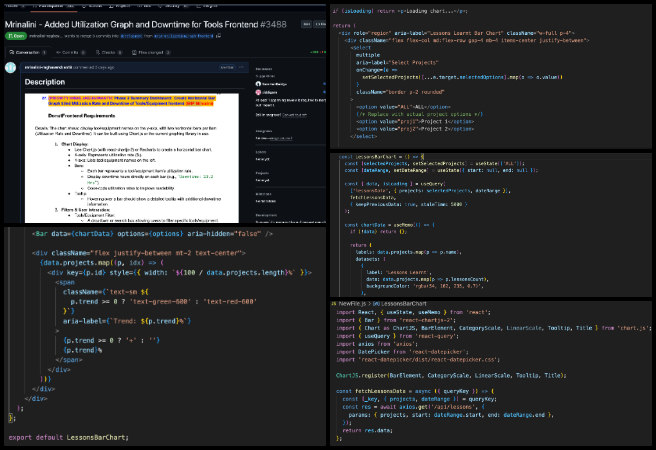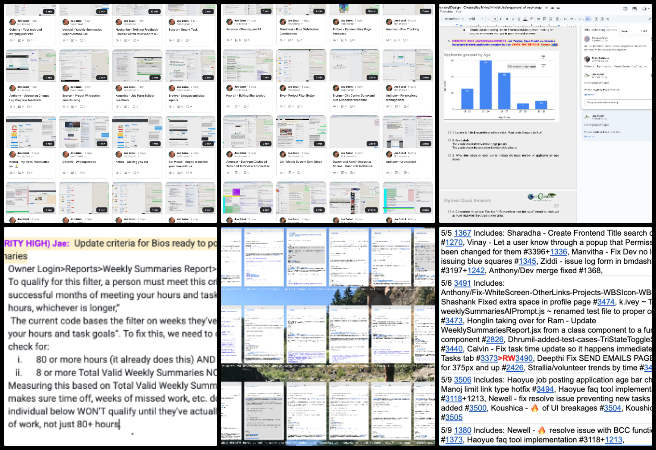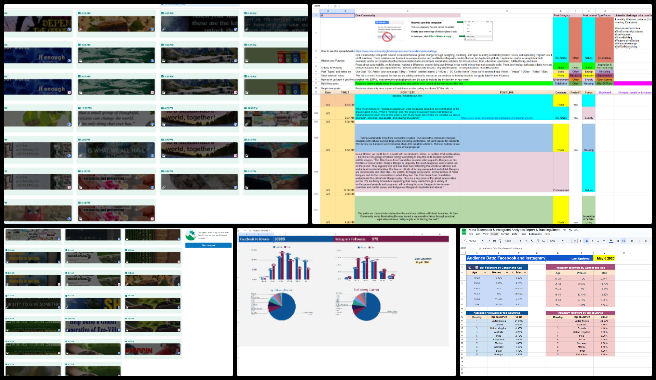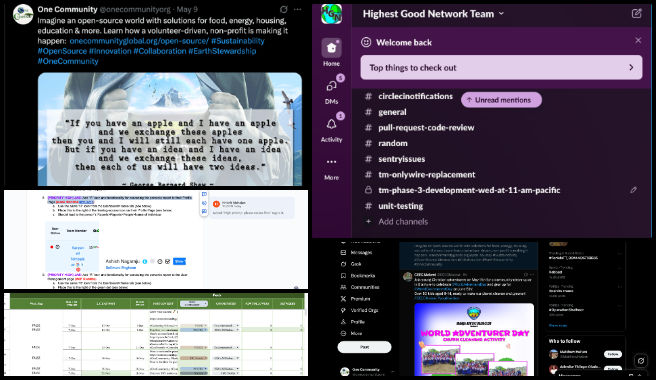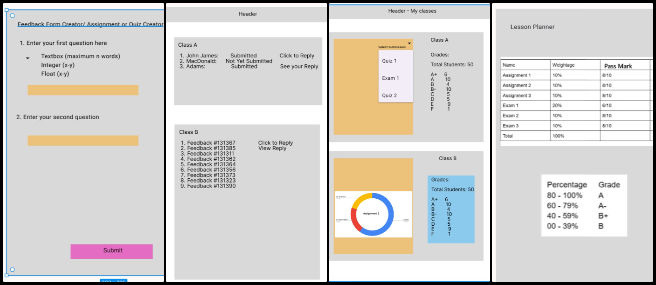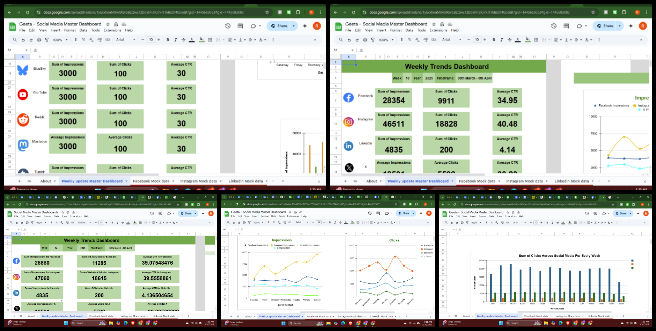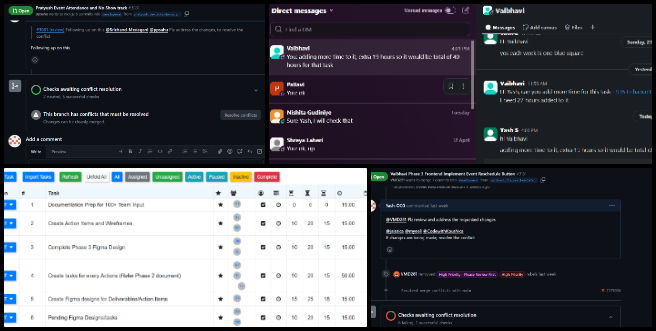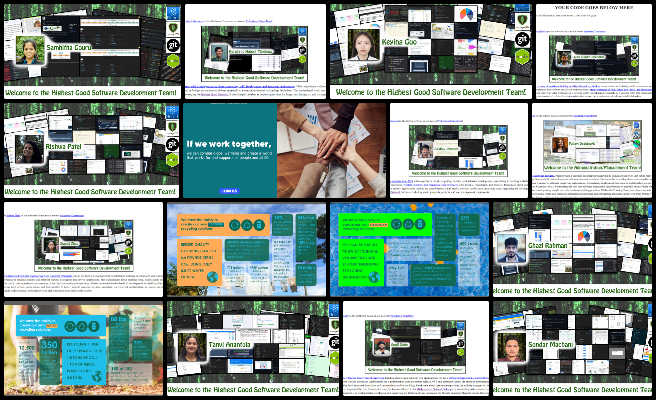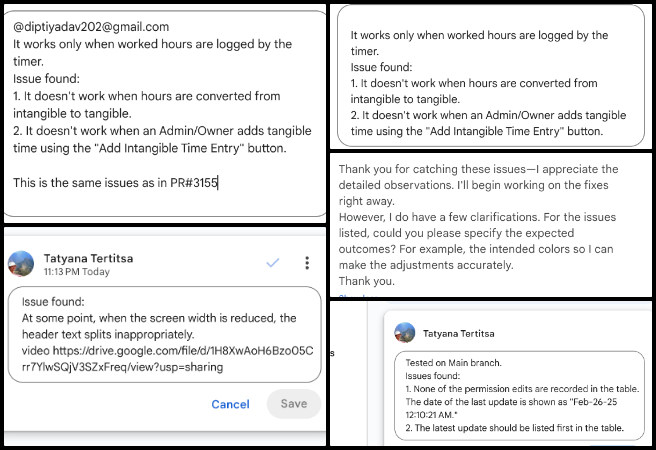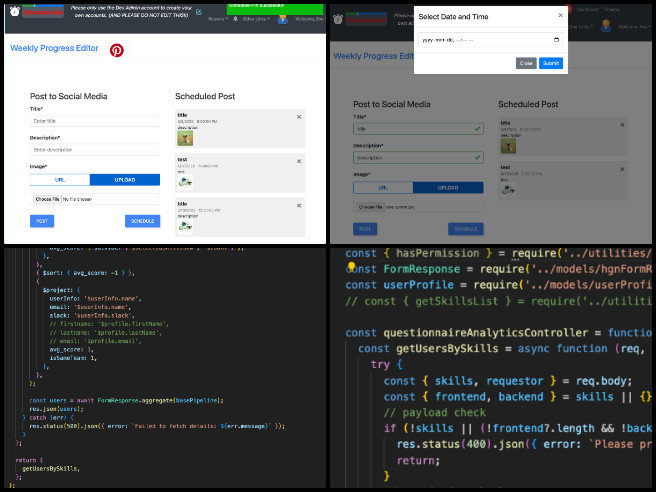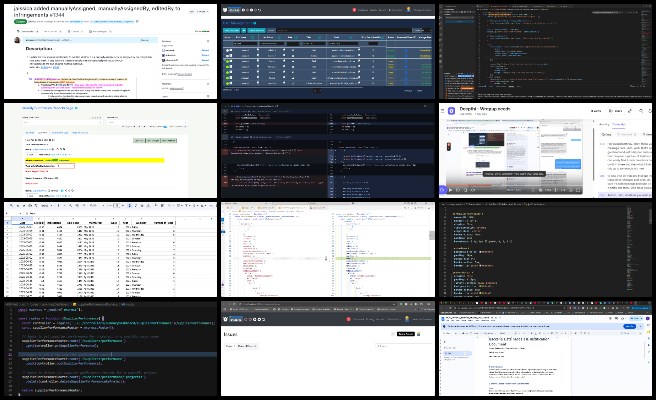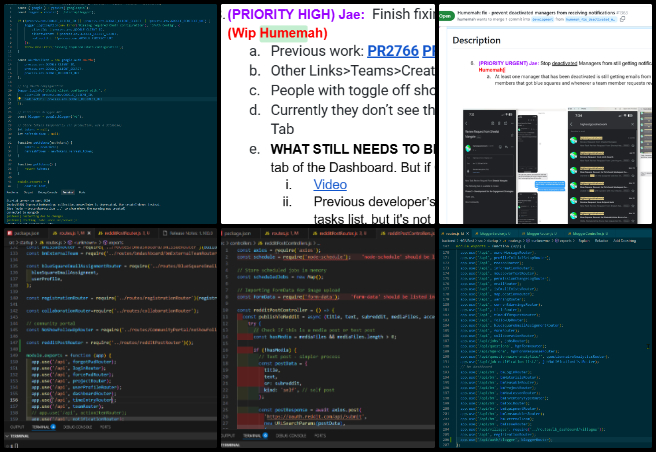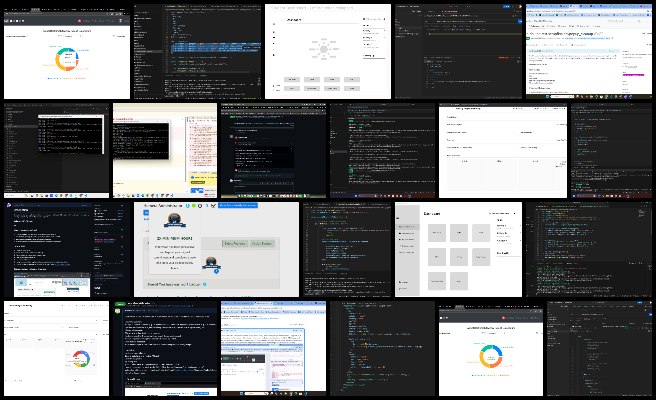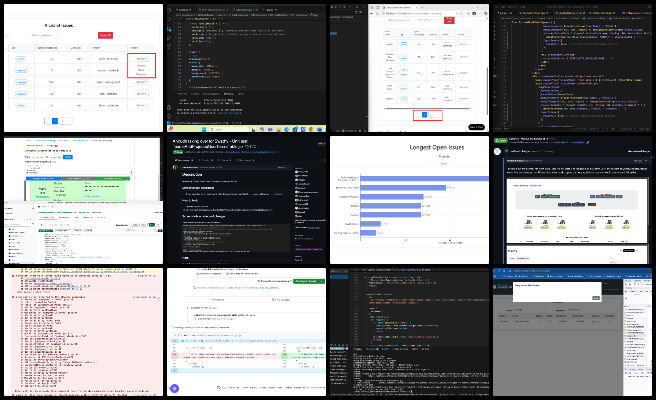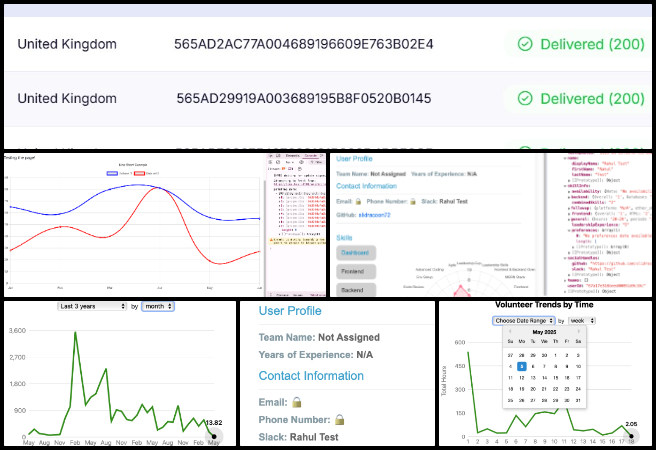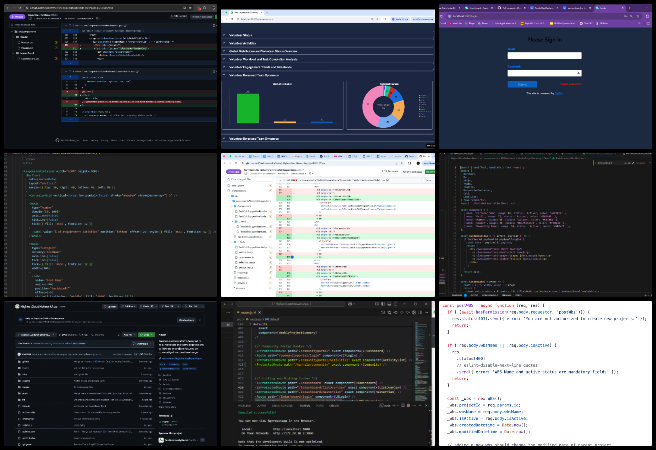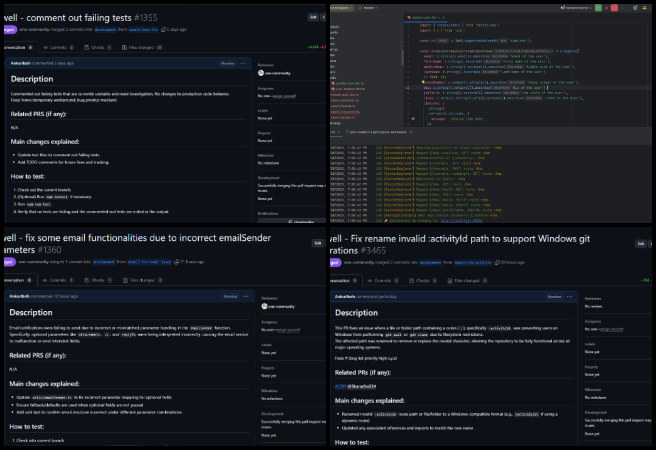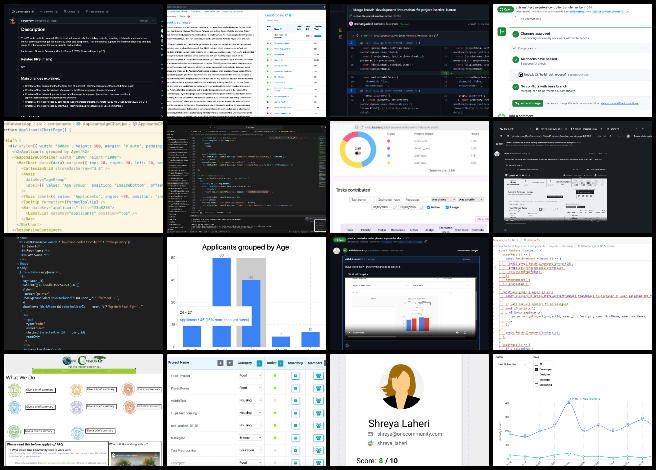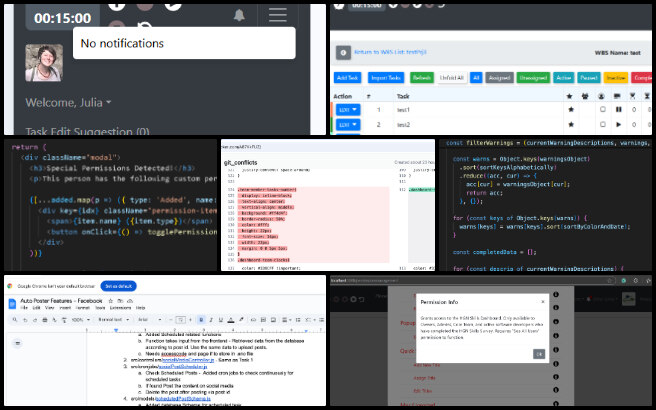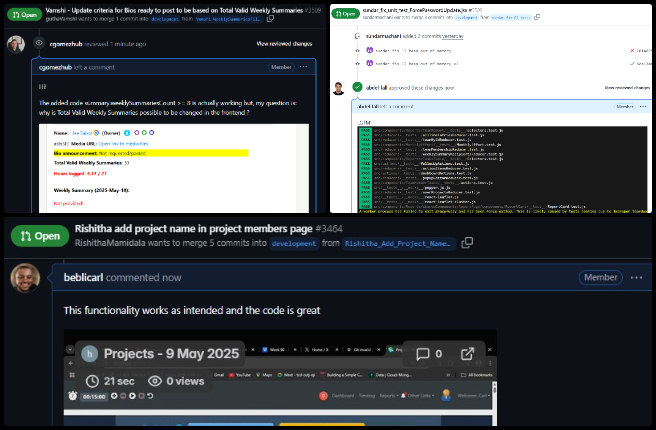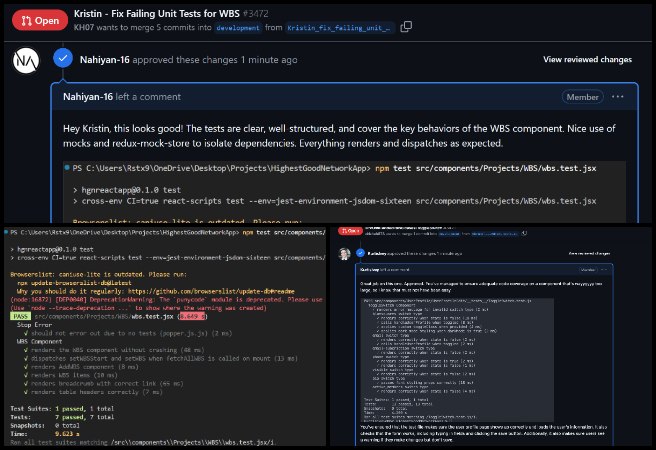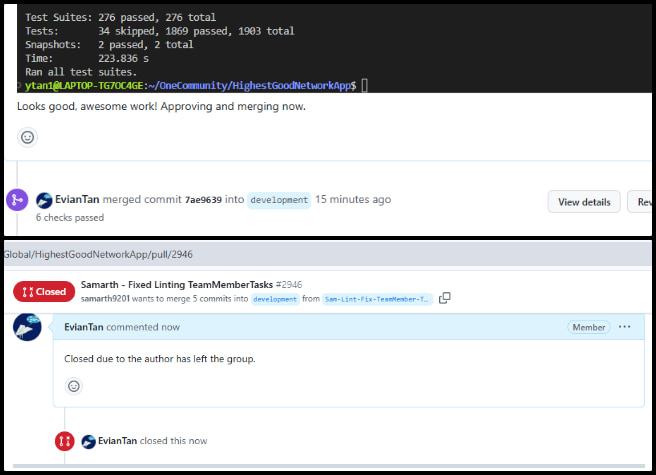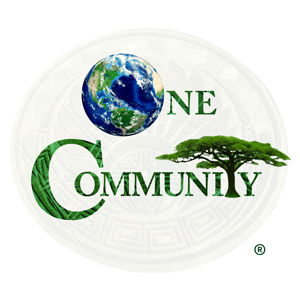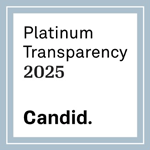New-paradigm Philanthropy and Change – One Community Weekly Progress Update #634
At One Community, we are demonstrating new-paradigm philanthropy and change to regenerate our planet and create a world that works for everyone. Our all-volunteer team is focused on sustainable approaches to food, energy, housing, education, economics, and social architecture. By open sourcing and free sharing the complete process, we aim to build a self-replicating model that inspires a global collaboration of teacher/demonstration hubs — all for “The Highest Good of All.” Together, we are evolving sustainability and fostering global stewardship practices that promote fulfilled living and lasting progress.
- Here’s our project overview
- Here’s our world-change methodology
- Here’s how this becomes self-replicating
- Here’s how we are open source and free-sharing all the do-it-yourself designs
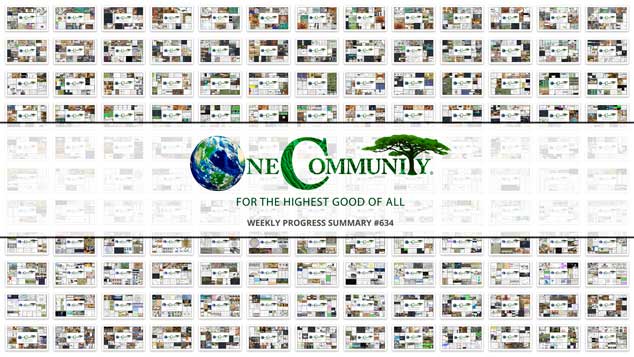
OUR MAIN OPEN SOURCE HUBS
Click on each icon to be taken to the corresponding Highest Good hub page.
One Community’s physical location will forward this movement as the first of many self-replicating teacher/demonstration communities, villages, and cities to be built around the world. This is the May 12th, 2025 edition (#634) of our weekly progress update detailing our team’s development and accomplishments:
New-paradigm Philanthropy and Change
One Community Progress Update #634
DONATE | COLLABORATE | HELP WITH LARGE-SCALE FUNDING
CLICK HERE IF YOU’D LIKE TO RECEIVE AN EMAIL EACH WEEK WHEN WE RELEASE A NEW UPDATE
YOU CAN ALSO JOIN US THROUGH SOCIAL MEDIA
ONE COMMUNITY WEEKLY UPDATE DETAILS
HIGHEST GOOD HOUSING PROGRESS
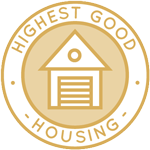 One Community is demonstrating new-paradigm philanthropy and change through Highest Good housing that is artistic and beautiful, more affordable, more space efficient, lasts longer, DIY buildable, and constructed with healthy and sustainable materials:
One Community is demonstrating new-paradigm philanthropy and change through Highest Good housing that is artistic and beautiful, more affordable, more space efficient, lasts longer, DIY buildable, and constructed with healthy and sustainable materials:
- Learn about: Our Upcoming Crowdfunding Campaign
- Learn about the different village models: 7 Sustainable Village Models
- Visit the open source portals for the first two: Earthbag Village OS Hub | Straw Bale Village OS Hub
This week, Adil Zulfiquar (Engineer) continued working on the Vermiculture Toilet engineering designs. Adil worked on the vermiculture master tracker file, reformatting and updating sections based on feedback to improve task tracking and organization for clarity. He also worked on the vermiculture temperature controls report by adjusting the content related to heating and cooling devices to make it clearer and easier to understand, and by adding additional devices to the list. The Earthbag Village, the first of seven planned villages, serves as the initial housing component within One Community’s open source model for new-paradigm philanthropy and change. See below for some of the pictures related to this work.
Audrey Gunawan (Mechanical Engineer) continued working on the Vermiculture Toilet plumbing details. Audrey worked on addressing issues related to the liquid waste outlet, focusing on modifying the model to reflect a connection to a septic system. Since the presence of the septic system outlet had not been confirmed, she based her adjustments on the assumption that the outlet would eventually be connected to a septic system located near the fan, although it has not yet been constructed in the waste box. She added additional pipes to the model to represent this future connection and researched the configuration requirements for the septic system. As the first of seven planned villages, Earthbag Village provides the initial housing within One Community’s open source designs for new-paradigm philanthropy and change. See below for some of the pictures related to this work.
Derrell Brown (Plumbing Designer) continued working on the Earthbag Village 4-dome home plumbing and mechanical details. Derrell coordinated with Michaela on Monday to address follow-up items related to finalizing the mechanical, plumbing, and electrical plans. He added penetration details based on the architectural sheets and updated the piping schedule to include properties of the refrigerant lines. To implement these updates, he referenced architectural drawings for earthbag wall construction and applied them to the dryer vent, refrigerant lines, roof vent, and conduit penetration details. After making these revisions, he plotted the mechanical, plumbing, and architectural plans for the architect’s final review. One Community’s open source launching of new-paradigm philanthropy and change begins with Earthbag Village, the first of seven planned villages providing housing. See below for some of the pictures related to this work.
Faeq Abu Alia (Architectural Engineer) continued his work on the Earthbag Village 4-dome home renders. Faeq worked on a walkthrough video render to showcase the updated outdoor space of the 4-dome home, which includes added natural features and landscaping elements. The work involved rendering the video and updating the exterior area of the project to reflect recent design changes. The Earthbag Village is the first of 7 to be built as the housing component of One Community’s open source plans for new-paradigm philanthropy and change. View examples of this work in the pictures provided below.
Karthik Pillai (Mechanical Engineer) continued helping finish the Earthbag Village 4-dome home roof plan. Karthik focused on the design of rafters and joists for the roof structure, using a revised design received from Michaela to extract specific dimensions for wooden beams and joists needed to support a more accurate finite element analysis. This data is being used to refine the structural model and improve the reliability of the analysis. In parallel, work continued on the vermiculture project, where Jae raised concerns about the design of the waste dumping structure through a Loom video. These concerns are under review, and a response is being prepared. Jae also provided suggestions on the vermiculture toilet design, which have been considered, and modifications are in progress based on this feedback and are being incorporated into the updated project report. As the first of seven planned villages, the Earthbag Village provides the initial housing within One Community’s open source designs for new-paradigm philanthropy and change. See the work in the collage below.
Ketsia Kayembe (Civil Engineer) continued working on the Earthbag Village designs related to Rainwater Harvesting and Water Catchment. Ketsia worked on revising the cost analysis for the Earthbag Village rainwater harvesting system based on feedback, which included updating unit prices and creating PDFs for each product with descriptions and specifications for easier access and reference. She also researched curb inlet sizing to support the development of stormwater management content for the Earthbag Village open source page. One Community’s open source model for new-paradigm philanthropy and change begins with Earthbag Village, the first of seven planned villages providing housing. See below for some of the pictures related to this work.
Michaela Silva (Architect) continued working on the architectural details for the Earthbag Village 4-dome home design. Michaela completed the preliminary roof joist plan using 2x10s spaced 16 inches on center and is working with the structural team to obtain updated roof calculations based on this configuration. She met with the MEP team to review the required details for earthbag wall penetrations where electrical and plumbing systems enter the home. She also prepared a detailed plan, elevation, and section for the built-in bookcases. As the first of seven villages in One Community’s open source plan for new-paradigm philanthropy and change, the Earthbag Village represents the housing element. See her work in the collage below.
Rumi Shah (Civil Engineer) continued working on the Earthbag Village upgrades to bring our designs closer to construction-ready plans. Two new drawing files titled A-102 and A-504 were created to support the detailed planning of the dome structure. File A-102 focuses on establishing precise line dimensions and the circular footprint of the dome to ensure accurate spatial alignment and scale. File A-504 contains the layout plan, illustrating the geometric positioning and orientation of the dome in relation to surrounding site elements. These drawings are intended to guide the construction process and verify all dimensional parameters before execution. One Community’s open source resources for new-paradigm philanthropy and change begin with the Earthbag Village, the first of seven planned villages providing housing. See below for some of the pictures related to this work.
Yi-Ju Lien (Environmental Engineer) continued her work on the Earthbag Village LEED points related to stormwater retention. Yi-Ju worked on the overall design of the stormwater management system. She reviewed the catchment area and verified that there were no discrepancies in total area calculations to ensure consistency across design components. Referencing the City of San Diego Drainage Design Manual, she considered roadway drainage requirements and evaluated the site’s elevation to meet minimum slope criteria. She also incorporated Low Impact Development features around the outer ring of the Earthbag Village to manage and accommodate runoff generated within the site, highlighting the importance of maintaining collaboration and unity in new-paradigm philanthropy and change. See some of the work done in the collage below.
DUPLICABLE CITY CENTER PROGRESS
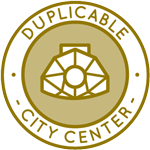 One Community is demonstrating new-paradigm philanthropy and change through a Duplicable and Sustainable City Center that is LEED Platinum certified/Sustainable, can feed 200 people at a time, provide laundry for over 300 people, is beautiful, spacious, and saves resources, money, and space:
One Community is demonstrating new-paradigm philanthropy and change through a Duplicable and Sustainable City Center that is LEED Platinum certified/Sustainable, can feed 200 people at a time, provide laundry for over 300 people, is beautiful, spacious, and saves resources, money, and space:
- Learn about this building and it’s function: Duplicable City Center Open Source Hub
This week, Ariana Virginia Gutierrez Doria Medina (Industrial Designer) continued the analysis and cost estimation of the windows for the Duplicable City Center. The assembly was completed, although minor gaps remain due to unclear images and missing measurements. These gaps are resolved for finalizing the assembly instructions and the detailed cutting list for each board. Additionally, a brief investigation into joinery techniques indicated that incorporating joinery biscuits and adhesive, enhance the overall stability and structural integrity of the build. As a cornerstone of One Community’s open-source initiative, the Duplicable City Center reflects our focus on new-paradigm philanthropy and change. Browse the photos below for a look at this work.
Jason Bao (Architectural Designer) continued working on producing renders for the Duplicable City Center library. The test renders of the exterior scene in video format were performed to assess system performance. Terrain elements were rearranged to improve scene composition, and non-essential assets were removed to optimize file efficiency. Technical issues within the model were resolved, and a video render profile was configured to standardize output settings. Camera angles for the render sequence were established, and the rendering process was initiated. Adjustments to workflows were prioritized to balance visual quality with system capabilities. Rooted in the principles of new-paradigm philanthropy and change, the Duplicable City Center exemplifies our open-source vision. See some of this work in the pictures below.
Manjiri Patil (Mechanical Design Engineer) continued working on the designs for the Duplicable City Center DIY-replicable hub connector. She has completed incorporating Jae’s review comments into the Excel sheet for the hub connectors, ensuring all specifications and design feedback have been accurately updated. She is integrating Jae’s feedback into the manufacturing process document as well, refining the details to align with structural and production guidelines. This work contributes to improved documentation quality and clarity. The Duplicable City Center is an open-source project designed to support new-paradigm philanthropy and change through replicable solutions. Browse the photos below for a look at this work.
Mihir Patki (Civil and Construction Engineer) worked on updating the 2D CAD drawings for the Duplicable City Center project. He continued work on the SketchUp model for the City Center water catchment system. He refined the placement of gutters and drainage pipes, made adjustments to the roof and catchment areas, and aligned the model with the CAD layout. Mihir created and integrated reusable components such as gutters and pipe spouts, and spent time organizing the model for easier future updates. He also searched through reference and work files to locate existing components and relevant details for cost analysis. Preliminary steps were taken to understand and begin structuring the cost analysis required for the system redesign. Built as part of our open-source vision, the Duplicable City Center advances new-paradigm philanthropy and change through transparent design. View the images below to explore the progress.
Rudrani “Sravya” Mukkamala (Mechanizal Engineer) continued researching the structural components of a Duplicable City Center hydraulic elevator. The focus was on researching installation methods and incorporating updates into the overview schematic. Work began on the modules, and efforts continued to explore various installation processes. Two installation manuals were identified, read, and annotated to help inform the development of a new manual. An additional document was found and included in the study. The research into installation methods was extended, and the process of reviewing and verifying key points was completed. With a solid understanding of the installation procedures now established, work has started on drafting the required document. With an open-source foundation, the Duplicable City Center drives forward new-paradigm philanthropy and change in community development. Pictures below highlight our work.
Shu-Tsun (Engineer) continued working on the Duplicable City Center by conducting the structural and frame analysis of the City Center dome using Autodesk Inventor, as well as working on the spreadsheet for which she is responsible. She concentrated on advancing the wind load assessment by collecting load magnitudes from a range of reliable sources and systematically organizing the data along with their references into a spreadsheet. Additionally, Shu-Tsun utilized actual project data to run a detailed simulation of the snow load, supporting the accuracy of her revised analysis. The Duplicable City Center showcases One Community’s open-source contribution to new-paradigm philanthropy and change. See the images below for more.
Srujan Pandya (Mechanical Engineer) continued helping with the Duplicable City Center FEA analysis. He completed the earthquake simulation analysis to be reviewed by Dipak Patil and discussed the model setup and result validity. It was confirmed that using steel as the beam material produced more reasonable results, consistent with previous versions that used ANSI Rolled Steel, and that changing the material was not an option. As the analysis was required for LVL 2 material, results for that case were also produced but found to be outside acceptable ranges, leading Dipak to proceed with running comparative simulations in ANSYS. He shared the dome and frame files for all three versions for this purpose. In parallel, he completed the color coding and formatting edits for the website content and sent it to Jae for feedback. Srujan also gathered information on relevant structural codes for dome structures, including both national and California-specific standards, and maintained a document to track the findings. Supporting new-paradigm philanthropy and change, the open-source Duplicable City Center is a model for sustainable, replicable design. Some examples can be seen in the photos below.
Yan “Jenni” Zu (Architectural Designer) continued her work on the greenhouse area of the Duplicable City Center. She added new facilities to the animal area and optimized the placement and types of trees within the space. The improvements aimed to enhance the overall functionality and visual effect of the animal area, making it more natural and engaging. She carefully adjusted the tree distribution to achieve a better balance between open space and vegetation, ensuring a more immersive environment. These updates contribute to a clearer expression of the design concept and help define the spatial organization more effectively. The changes also support the aesthetic and ecological goals of the project. One Community’s open-source Duplicable City Center exemplifies our commitment to new-paradigm philanthropy and change in action. View related images below.
HIGHEST GOOD FOOD PROGRESS
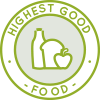 One Community is demonstrating new-paradigm philanthropy and change through Highest Good food that is more diverse, more nutritious, locally grown and sustainable, and part of our open source botanical garden model to support and share bio-diversity:
One Community is demonstrating new-paradigm philanthropy and change through Highest Good food that is more diverse, more nutritious, locally grown and sustainable, and part of our open source botanical garden model to support and share bio-diversity:
- Learn about the structures: Hoop House Hub | Aquapini & Walipini Open Source Hub
- See what we’ll be growing: Gardens & Hoop Houses | Large-scale Structures | Food Forest | TA
This week, Chelsea Mariah Stellmach (Project Manager) continued her work on the Transition Food Self-sufficiency Plan menus and customization spreadsheets. She revised the Recipe Build-Out Tool Page Report and the Updated Food Self-Sufficiency Plan Page Report based on feedback from Jae. She sourced updated images and compiled them into a shareable Dropbox file. Changes to the reports included replacing previous headings with tighter versions, adding context to bullet point lists, and removing sub-bullets. One of the reports appears to be complete, while the other may require an additional round of minor feedback. She is now preparing to create a video tutorial to accompany the written tutorial. As an essential aspect of One Community’s open source goals, the Highest Good Food initiative supports new-paradigm philanthropy and change as a foundation for sustainable living. Below are some of the images showcasing this work.
Dirgh Patel (Volunteer Mechanical Engineer) continued assisting with the Climate Battery design evolutions. He completed reading climate battery and geothermal greenhouse systems, focusing on undersoil ventilation powered by solar fans and the use of insulated concrete form (ICF) walls for temperature regulation and rodent prevention. He studied multiple greenhouse heating techniques, including thermal mass strategies like water barrels and underground heat exchangers, as well as renewable and conventional heating systems such as rocket mass heaters, compost-pile heaters, electric, and propane heaters. He explored the advantages and limitations of water barrels versus phase change materials (PCMs) for heat storage and their impact on available growing space. He reviewed the use of stone or brick floors and containers for passive heat regulation. Dirgh read innovative growing techniques such as Hügelkultur, hydroponics, aquaponics, vertical gardening, companion planting, and succession planting to increase space efficiency and crop productivity. One Community’s open source mission is powerfully reflected in the Highest Good Food initiative, which is focused on advancing new-paradigm philanthropy and change for global benefit. The following visuals highlight key outcomes of this initiative.
Jay Nair (BIM Designer) continued working on Aquapini and Walipini Planting and Harvesting lighting and HVAC design. He modified the content of the DLI report and included several detailed sections to enhance its clarity and relevance to the project. The added sections were: Definition and Significance of DLI, Relationship Among DLI, PPFD, and Photoperiod, Challenges in DLI Management in Greenhouses, Greenhouse Lighting Strategy and Design Solutions, Effects of Excess DLI and Environmental Interactions, Implementation and Operational Considerations, Consequences of Improper DLI Management, Summary and Importance for the Project, and Conclusions. The Highest Good Food initiative plays a leading role in One Community’s open source platform, promoting new-paradigm philanthropy and change through sustainable and participatory development. Below are some of the images showcasing this work.
Keerthi Reddy Gavinolla (Software Developer) continued working on the Highest Good Food page additions, covering small-business and urban community options. She updated the Expresses Team’s Blog #633 and continued work on the Highest Good Food Infrastructure website. She also submitted the updated version to Jae for review and made the suggested changes edited bullet points, justified text, adjusted heading levels, such as changing h3 to h2, and fixed formatting issues for better consistency and readability. Built on One Community’s open source foundation, the Highest Good Food initiative drives new-paradigm philanthropy and change to empower communities with self-sustaining systems. Her contributions are highlighted in the collage below.
Pallavi Deshmukh (Software Engineer) continued working on adding the new Zenapini 2 content to the Aquapini and Walipini Planting and Harvesting page. She completed eight interviews related to software development and administrative roles and submitted the required details. Based on feedback received from Jae regarding the permaculture web page, she updated her links for images. Work continued on the Aquapini and Walipini Planting and Harvesting web page, including editing images and adjusting text to meet specified requirements. The layout and structure of the new web page are currently being refined. Fulfilling One Community’s open source objectives, the Highest Good Food project integrates new-paradigm philanthropy and change into a larger vision of regenerative living. Her contributions are highlighted in the collage below.
Tanmay Koparde (Industrial Engineer and Team Administrator) continued optimizing the Food Procurement and Storage Plan to enhance efficiency and sustainability. He initiated key supply chain concepts within the context of the existing food menu and procurement system. He carried out an in-depth analysis of FIFO, LIFO, Just-In-Time procurement, and SAP modules, including MM (Materials Management) and EWM (Extended Warehouse Management). His evaluation focused on the storage practices currently in use, assessing the applicability of each concept within the project’s scope. Tanmay identified the strengths and limitations of each approach and developed clear, actionable steps for integrating these methodologies into current workflows, aiming to optimize inventory rotation, minimize waste, and streamline procurement and storage operations. Through the lens of open source development, One Community’s Highest Good Food initiative utilizes new-paradigm philanthropy and change to support replicable ecological solutions. See his work in the collage below.
HIGHEST GOOD ENERGY PROGRESS
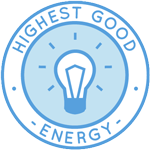 One Community is demonstrating new-paradigm philanthropy and change through Highest Good energy that is more sustainable, resilient, supports self-sufficiency and includes solar, wind, hydro and more:
One Community is demonstrating new-paradigm philanthropy and change through Highest Good energy that is more sustainable, resilient, supports self-sufficiency and includes solar, wind, hydro and more:
- Learn about the open source sustainable-energy foundations: Solar, Hydro, and Wind
- Explore our research into the most sustainable products and companies for saving water and energy: Insulation, Eco-laundry, Lightbulbs and Light Bulb Companies, Doors and Door Companies, Windows and Window Companies, Toilets, Faucets and Faucet Accessories, Urinals, and more.
This week, Dishita Jain (Data Analyst) continued assisting with the Highest Good Energy research and cost analysis for new-paradigm philanthropy and change. She focused on tasks related to the Energy Infrastructure Cost Analysis and Visualizations project for HG Energy. She updated the Excel sheet based on feedback from Jae regarding solar energy infrastructure and completed the icon list comparison for various sections, including HG Energy, HG Food, and HG Society, with the search engine. In parallel, Dishita worked on the OC Administration project, completing the team review by adding a summary and creating a collage, while also reviewing the work of other administrators. One Community’s open source mission is powerfully reflected in the Highest Good Energy initiative, which is focused on advancing new-paradigm philanthropy and change for global benefit. Below are some of the images showcasing this work.
HIGHEST GOOD EDUCATION PROGRESS
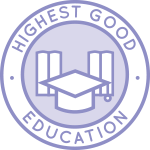 One Community is demonstrating new-paradigm philanthropy and change through Highest Good education that is for all ages, applicable in any environment, adaptable to individual needs, far exceeds traditional education standards, and more fun for both the teachers and the students. This component of One Community is about 95% complete with only the Open Source School Licensing and Ultimate Classroom construction and assembly details remaining to be finished. We’ll report on the final two elements to be finished as we develop them. With over 8 years of work invested in the process, the sections below are all complete until we move onto the property and continue the development and open sourcing process with teachers and students – a development process that is built directly into the structure of the education program and everything else we’re creating too:
One Community is demonstrating new-paradigm philanthropy and change through Highest Good education that is for all ages, applicable in any environment, adaptable to individual needs, far exceeds traditional education standards, and more fun for both the teachers and the students. This component of One Community is about 95% complete with only the Open Source School Licensing and Ultimate Classroom construction and assembly details remaining to be finished. We’ll report on the final two elements to be finished as we develop them. With over 8 years of work invested in the process, the sections below are all complete until we move onto the property and continue the development and open sourcing process with teachers and students – a development process that is built directly into the structure of the education program and everything else we’re creating too:
- Program Overview: Education Open Source Hub
- How the components work together in designing human orchestrated eco-abundance: How to use the Education for Life Program
- Lesson Plans for Life – Lesson Plans How-to
- Foundations of Outstanding Leaders, Teachers, and Communicators
- Curriculum for Life
- Teaching Strategies for Life
- Learning Tools and Toys for Life
- Evaluation and Evolution
This week, Akhil Guntur (FullStack Engineer) continued his work on enhancing and refining his backend model documentation, carefully exploring multiple backend design approaches. He focused on evaluating improvements to the system architecture of the Highest Good Education platform. He researched design patterns and frameworks to enhance scalability, modularity, and long-term maintainability. A major focus was analyzing the hierarchical structure of lesson plans, atoms, molecules, and tasks to establish a reusable content structure. He identified conceptual challenges that need further discussion with the team for clarification. Additionally, Akhil reviewed and analyzed the UML diagrams shared by team members to align backend requirements with the proposed architecture. He shared comments and questions on Slack to support the design discussion. This helped ensure the development path aligns with the platform’s intended functionality and educational goals. The One Community approach to new-paradigm philanthropy and change is powerfully demonstrated through sustainably constructed classrooms that serve the planet as a whole. See the collage below for his work.
Chitra Siddharthan (Data Analyst and Team Administrator) continued focusing on the weekly summary, blog, and Dropbox files for the Code Crafters team for week 633 and reviewed the work of Dishita and Tanmay. She added tasks and responded to Slack messages while researching backend and MongoDB-related issues in Phase 2 based on Ganesh’s queries. She reviewed Admin-in-Training Meghan’s blog, document, and Dropbox file and provided feedback. She addressed pending Slack messages from Harshitha, Ravi, and Anuneet, checked the work progress of Anuneet and Ravi, and reviewed Ravi’s completed Login Pages for Phase 4. Chitra created a brief description for the “Teacher Dashboard – Student List Snapshot” and continued working on its Figma wireframe. She also addressed issues raised by developers regarding task visibility on their dashboards, updated tasks added in recent days after the bug fix, and escalated Manvitha’s continued issue to Jae for further action. Additional tasks were added to Phase 2, and she reviewed Admin-in-Training Neeharika’s blog, document, and Dropbox file, providing necessary input. Chitra also worked on the documentation for the “Teacher Dashboard – Student List Snapshot” wireframe and had a meeting with Ravi to address his questions about the Figma wireframes. This sustainably built classroom represents the impact of One Community’s model of new-paradigm philanthropy and change, driving meaningful global transformation. See the collage below for her work.
Harshitha Rayapati (Program Manager) continued work on detailing deliverables for the Highest Good education software platform, outlining various components, developing Figma designs, and expanding the visual layout of the student dashboard. This week, her work focused on reviewing the Figma design for the teacher dashboard early wireframe designed by Chitra with specific emphasis on the student snapshot view, and explaining the key functions and links related to the student profile page. Comments were also added to the UML diagram for backend models shared by Sidhartha, including an explanation of how lesson plan activities break down into sub-tasks and how sub-task completion affects the overall activity progress, supported with an illustrative example. Collaboration with Ravi involved detailing the student dashboard home view, clarifying interactions with other screens, and reviewing early side navigation designs for various user profiles. Progress check-ins were set up with all team members. Additionally, worked on putting together the weekly blog update for the Graphic Design Team. The One Community model of new-paradigm philanthropy and change with sustainably built classrooms like this is an excellent example of sustainable change for the whole planet. See the collage below for her work.
Mrinalini Raghavendran (Software Engineer) continued refining and documenting both frontend and backend requirements for various graphs. She refactored the existing code and moved the styling into a separate CSS file, though the pull request for those changes has not yet been pushed. She finalized the code for the Utilization Chart task and created a pull request in the frontend repository. After that, she picked up a new task from the documentation and began working on it. She started building a React component for the new task in the frontend codebase and added some basic styling. Also, Mrinalini continued working on the task by expanding the component’s functionality and adding more styling. By forwarding new-paradigm philanthropy and change with classrooms like this, One Community provides a replicable example for global sustainable development. See the collage below for her work.
HIGHEST GOOD SOCIETY PROGRESS
 One Community is demonstrating new-paradigm philanthropy and change through a Highest Good society approach to living that is founded on fulfilled living, the study of meeting human needs, Community, and making a difference in the world:
One Community is demonstrating new-paradigm philanthropy and change through a Highest Good society approach to living that is founded on fulfilled living, the study of meeting human needs, Community, and making a difference in the world:
- Read the Highest Good society overview: Highest Good Society
- Learn about the model for fulfilled living and sharing: A Day in the Life
- Learn about the 4 economic models: RBE | For-profit | Non-profit | Entrepreneurship
- Learn about our open source community collaboration and management software: The Highest Good Network
This week, the core team completed over 46 hours managing One Community’s volunteer-work review not included above, emails, social media accounts, web development, new bug identification and bug-fix integration for the Highest Good Network software, and interviewing and getting set up new volunteer team members. They also shot and incorporated the video above that talks about new-paradigm philanthropy and change and how new-paradigm philanthropy and change are a foundation of the bigger picture of everything One Community is doing. The image below shows some of this work.
Govind Sajithkumar (Project Manager) continued focusing on Meta platform analytics and content management for Facebook and Instagram channels. He refreshed both social media feeds with new posts and scheduled content to maintain regular publishing intervals. He documented all content metadata in the Open Source spreadsheet, including publishing times, content descriptions, and associated media files to support accurate tracking. Govind updated audience metrics for both platforms, performing quality checks to ensure data integrity throughout the reporting frameworks. All relevant spreadsheets and dashboards were refreshed with the most recent performance data to facilitate ongoing analysis. Additionally, he handled administrative responsibilities including PR Review Team management, providing feedback on team member documents, updating his WordPress site with team summaries, maintaining PR tracking tables, and participating in the admin feedback process. This effort supports One Community’s broader mission of new-paradigm philanthropy and change. The images below showcase some of this work.
Hritvik Mahajan (Data Analyst) continued focusing on marketing and administrative tasks. For the Marketing and Promotion project, he focused on posting the highest engagement content across Twitter communities and managing post strategy based on prior performance data. He also performed related research to guide future postings. For the HGN Software Development project, he reviewed multiple pull requests as part of the Phase 1 Software Frontend Testing work. Hritvik communicated with team members on Slack regarding requested changes and merge conflict resolutions. His tasks involved identifying outstanding issues in the PRs, providing relevant feedback, and verifying whether the changes were reflected in the development environment. He continued following up with contributors to help move forward with pending requests. This initiative furthers One Community’s goal of advancing new-paradigm philanthropy and change. The following images show his work for the week.
Jaiwanth Reddy Adavalli (Project Manager) continued developing the Job Applicants page and the Highest Good Network Phase 2 Dashboard. He contributed to the HGN Phase 4 software by designing several wireframe pages for the Student and Teacher dashboards within the Highest Good Education suite. He outlined detailed action items to support the next steps in development and ensure alignment with project goals. As a member of the PR Review Team, he evaluated pull requests submitted by assigned volunteers, offering targeted feedback and ensuring adherence to project standards. This project plays an important role in One Community’s commitment to new-paradigm philanthropy and change. The following images show his work for the week.
Raghav Dinesh Pamuru (Product Manager) continued work on coordinating with cross-functional teams to update the project roadmap and ensuring that all development tasks aligned with weekly goals. He coordinated a product feature rollout to improve user onboarding, aligned cross-functional teams, and used data analytic tools to analyze funnel data. He collaborated on validating Tableau dashboards, documented feedback in Google Sheets, and updated project plans. Additionally, Raghav built a mock social media dashboard by integrating data from 20 platforms, edited charts and tables for clarity, refined formatting and data mappings, and made layout adjustments to improve usability and structure. It directly contributes to One Community’s mission of creating systems rooted in new-paradigm philanthropy and change. The images below showcase some of this work.
Yash Shah (Data Analyst and Team Administrator) continued his admin work and managed the social architecture component of the Highest Good Network software. He followed up directly on GitHub by tagging reviewers and pull request owners to address unresolved conflicts and help move pending submissions forward. He completed a second round of check-ins to confirm whether requested changes had been made and if additional action was required, which helped clarify approval statuses and prompt responses. He also added time to tasks aimed at improving link handling and continued coordination around conflict resolution. Additionally, Yash created a blog post for Dev Dynasty, organized the week’s folder, assembled a collage, and provided constructive feedback on blog posts submitted by fellow volunteers. This work strengthens One Community’s pursuit of new-paradigm philanthropy and change. The following images show his work for the week.
ADMINISTRATION TEAM
The Administration Team summary, covering their work administrating and managing most of One Community’s ongoing process for new-paradigm philanthropy and change, was managed by Bhakti Tigdi (Project Manager) and includes Anuneet Kaur (Administrator), Himanshu Mandloi (Engineering Project Manager), Jibin Joby (Data Analyst), Khushie Zaveri (Communication Strategist), Kishan Sivakumar (Administrative Assistant and Software Team Manager), Neeharika Kamireddy (Data Analyst), Olawunmi “Ola” Ijisesan (Administrative and Management Support), Olimpia Borgohain (Data Analyst and Team Administrator), Rachna Malav (Data Analyst), Rishi Sundara (Quality Control Engineer and Team Administrator), Ryutaro Wongso (Economic Analyst and Team Administrator), Saumit Chinchkhandi (Administrative Assistant and Software Engineer), Vikas Pande (Software Administrator), and Vishnu Murali (Data Analyst). The Highest Good Network software is how we’ll be managing and objectively measuring our process for new-paradigm philanthropy and change through our social architecture, construction, production, and maintenance processes.
This week, the Administration Team contributed across areas including technical coordination, team training, content development, and platform engagement. Anuneet researched sustainable paper alternatives, and compiled statistics to support graphic development, while drafting and revising content for the Highest Good Education Program webpage. She also supported new team member onboarding by providing feedback, verifying contributions, and coordinating bio announcements. Himanshu handled daily timelog reviews, created and resolved tasks, and reported engagement concerns to leadership. He also developed a blog focused on global sustainability systems management and reviewed team performance. Jibin collaborated with Vishnu on refining BlueSky analytics and reporting strategies, updated housing team content, and continued regular posting to increase platform interaction. Khushie launched Reddit outreach for the metric system campaign, began using Mastodon for sustainability messaging, and developed email templates for internal outreach, while reviewing trainee submissions as part of onboarding support. Kishan reviewed and edited volunteer documentation and SEO pages, addressed team feedback, and began new administrative assignments. Neeharika advanced through onboarding and training, completed process steps for five team members, revised content based on feedback, and submitted her final updates. This work aligns with One Community’s mission of fostering new-paradigm philanthropy and change.
Ola completed Pinterest scheduling for the month, resized images for clarity, and reviewed PR data for accuracy. Olimpia reviewed admin work, updated blog content, and optimized social media posts for LinkedIn with revised copy and hashtags. Rachna focused on updating pending SEO content and stayed engaged via email and team platforms due to limited interview availability. Rishi merged blog entries into Blog #633, implemented SEO optimization, and tested several pull requests in multiple documentation phases, while managing team assignments and reviewing training content. Ryutaro continued building a duplicable cost template for the city center, provided feedback on development outputs, and published a blog summarizing progress. Saumit managed PR workflows for multiple contributors, conducted extensive frontend testing, updated WordPress content, and provided blog feedback. Vikas validated member bios and technical inputs, updated scripts for content accuracy, and finalized his contributions in his last week. Vishnu updated BlueSky metrics, fixed data issues, and maintained platform engagement through daily posts, while coordinating visual strategy updates with Jibin and revising Blog #633 based on peer feedback. This work contributes to One Community’s commitment to new-paradigm philanthropy and change. See below to view images of their work.
GRAPHIC DESIGN TEAM
The Graphic Design Team’s summary was managed by Harshitha Rayapati (Program Manager) and includes Aurora Juang (Graphic Designer), and Junyuan Liu (Graphic Designer, UI/UX Designer) covering their work on graphic designs for new-paradigm philanthropy and change. This week, Aurora created multiple social media posts and managed volunteer announcements, finalized chapter icons for the Seven Villages book and website, fixed broken links in the digital edition, and corrected earlier errors in bio announcements. She used Google Sheets to publish new volunteer bios with a focus on accuracy and consistency, which supported improved team coordination and onboarding.
Junyuan created social media content by collecting images, exploring design options in design software, and brainstorming strategies for future visuals. In addition to social media work, Junyuan wrote volunteer bios, designed supporting graphics, edited information on a web page, and contributed to the “Most Sustainable” image by researching, writing accompanying text, adjusting the layout, and revising previous content based on feedback. See the Highest Good Society pages for more on how this contributes to new-paradigm philanthropy and change. See the collage below to view some of their work.
HIGHEST GOOD NETWORK PROGRESS
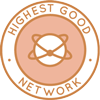 One Community is demonstrating new-paradigm philanthropy and change through open source Highest Good Network® software that is a web-based application for collaboration, time tracking, and objective data collection. The purpose of the Highest Good Network is to provide software for internal operations and external cooperation. It is being designed for global use in support of the different countries and communities replicating the One Community sustainable village models and related components.
One Community is demonstrating new-paradigm philanthropy and change through open source Highest Good Network® software that is a web-based application for collaboration, time tracking, and objective data collection. The purpose of the Highest Good Network is to provide software for internal operations and external cooperation. It is being designed for global use in support of the different countries and communities replicating the One Community sustainable village models and related components.
- Learn about our open source community collaboration and management software: The Highest Good Network
This week, the core team continued their work on the Highest Good Network PRs and confirmed the following as fixed: editing Blue Squares without a page refresh (#3247), formatting issues when editing tasks from the Work Breakdown Pages (#3300), button layout adjustments (#3336), Weekly Summary toggle button formatting (#3338), task selection effort display (#3320), and saving and auto-populating WBS content during the auto-refresh popup (#3346, #1298). The following items were not fixed: delay in hour count updates for individual tasks when converting intangible to tangible time (#3155), Timelog totals not matching task time worked when Admins or Owners add tangible time using the “Add Intangible Time Entry” button (#1287), permission management logs not recording updates (#3214, #1254), and leaderboard header formatting issues for various screen sizes (#3345), for which a video was provided. They also assigned tasks to two volunteers and provided input on font and background color selections to support improvements for more consistent dark mode implementation (#3168). These improvements represent incremental steps towards the realization of new-paradigm philanthropy and change. See the Highest Good Society and Highest Good Network pages for more on how this relates to new-paradigm philanthropy and change. The collage below shows some of their work.
ALPHA SOFTWARE DEVELOPMENT TEAM
This week, the Alpha Software Team, covering their progress on the Highest Good Network software, was managed by Lin Khant Htel (Frontend Software Developer), and the team includes Eve Ye (Volunteer Software Engineer Intern), Jiaqi Nie (Software Engineer), and Nikita Kolla (Full Stack Developer). This software is an internal management and communication platform with the goal of achieving new-paradigm philanthropy and change. Lin reviewed and approved PR #3472 after testing it on a local machine and confirming that all test cases passed. Lin also reached out to team members for consultation, reviewed Alpha team members’ weekly summaries, photos, and videos, and handled management duties for the Alpha Team. This work reflects One Community’s ongoing commitment to new-paradigm philanthropy and change.
Eve made adjustments to the entire Pinterest auto-post functionality based on Jae’s feedback. She created a distinct page specifically for Pinterest posts to align with the platform’s format and content requirements. The post form was updated to support both image URLs and file uploads, with validation added to all fields to prevent invalid input. She also introduced a new scheduling feature that allows users to set posts for future publishing and provides the option to cancel scheduled events. Jiaqi received a new task to implement the Dynamic Scoring and Ranking Logic for the questionnaire dashboard backend. He focused on understanding the existing logic of the code and reviewing the notes left by the previous developer regarding known issues. He spent time identifying the areas in the code that require changes to meet the new requirements. Jiaqi planned to begin addressing the problems identified in the code on Saturday. Nikita continued work on the Phase 2 Summary Dashboard task, the Horizontal Bar Graph of P5. She completed the longest open issues chart and built the foundation for the most expensive issues task. Final testing and CSS polishing are still pending before raising a pull request for this task. See the images below for more illustrations of the team’s work, reflecting the vision of new-paradigm philanthropy and change.
BINARY BRIGADE SOFTWARE DEVELOPMENT TEAM
The Binary Brigade Team’s summary overseeing advancements in the Highest Good Network software was managed by Aureliano Hubert Maximus (Volunteer Software Engineer) and includes Amalesh Arivanan (Software Engineer), Anirudh Sampath Kumar (Software Developer), Deepthi Kannan (Software Engineer), Geeta Matkar (Software Engineer), Jaissica Hora (Software Engineer), Nikhil Routh (Software Engineer), Samman Baidya (Software Engineer), Sidhartha Sunkasari (Software Engineer), Sriram Seelamneni (Software Engineer), Sunil Kotte (Full Stack Developer), and Vamshi Gutha (Full-Stack Developer). The Highest Good Network software is how we’ll be managing and objectively measuring our progress in demonstrating new-paradigm philanthropy and change through our social architecture, construction, production, and maintenance processes.
This week, Amalesh fixed the pause/reactivation feature for user status by implementing a daily check that reactivates users whose “Paused Until” date had passed, representing new-paradigm philanthropy and change through improved automation. Amalesh also resolved linting issues and failing tests, uploaded documentation to Dropbox, and tracked time while completing onboarding steps for project continuity. Aureliano built the Instagram/Threads auto-poster feature by integrating custom login, long-lived token access, and frontend/backend updates, highlighting new-paradigm philanthropy and change through enabling seamless outreach tools. Aureliano also added scheduling functionality with backend routes and frontend UI for post management. Deepthi resolved a dropdown overlap issue in Team Member Tasks using a CSS fix for z-index conflicts but deleted the pull request due to a Husky pre-commit error, showcasing new-paradigm philanthropy and change by documenting the issue for smooth handoff. Deepthi confirmed May 12th as the final workday and ensured time was logged.
Anirudh resolved merge conflicts in multiple frontend and backend pull requests while investigating failing test cases, representing new-paradigm philanthropy and change by supporting permissions updates and code integrity. Anirudh also corrected and resubmitted a flawed file in PRs 2765 and 1763 after pushing final updates. Geeta enhanced a dashboard by adding user account and mock data for graph generation and made the weekly data view dynamic, highlighting new-paradigm philanthropy and change through actionable insights in visual analytics. Geeta also incorporated post count requirements into the system. Jaissica developed backend support for a donut chart, updated blue square assignment logic, and added tracking fields to improve traceability, Illustrating new-paradigm philanthropy and change through transparent data handling. Jaissica also reorganized the dashboard display logic and reviewed teammate work for documentation. Nikhil modified 260 files to convert traditional CSS to CSS Modules by updating imports and class references, demonstrating new-paradigm philanthropy and change through scalable and maintainable styling practices. Nikhil also resolved compatibility issues related to dynamic class handling. Samman progressed on the injury tracking database by switching from mock data to building necessary backend APIs and updating the frontend, showcasing new-paradigm philanthropy and change by prioritizing sustainable data handling. Samman also fixed a previously reported view issue for re-evaluation.
Siddhartha designed backend data models and UML diagrams for an education portal, focusing on entity relationships and authentication discussions, exemplifying new-paradigm philanthropy and change through thoughtful infrastructure design. Siddhartha received feedback on model relationships and began revisions. Sriram developed services and backend routing for the Supplier Performance graph and connected the frontend to render data accurately, advancing new-paradigm philanthropy and change by improving performance visibility. Sriram made steady progress toward finalizing the feature. Sunil updated the backend user schema to include an endDate and implemented filtering logic in both frontend and backend, forwarding new-paradigm philanthropy and change by supporting more accurate reporting. Sunil encountered data leak issues and began refining frontend filters. Vamshi revised the logic for Bio Status readiness by ensuring filters reflected actual participation via hours and valid summaries, demonstrating new-paradigm philanthropy and change by aligning systems with contribution-based values. Vamshi tested the updates and submitted a pull request, awaiting confirmation from JAE. See the Highest Good Society and Highest Good Network pages for more on how this relates to delivering new-paradigm philanthropy and change. View some of the team’s work in the collage below.
BLUE STEEL SOFTWARE DEVELOPMENT TEAM
The Blue Steel Team’s summary, presenting their work on the Highest Good Network software was managed by Sheetal Mangate (Software Engineer) and includes Humemah Khalid (Software Engineer/Backend Developer), and Linh Huynh (Volunteer Software Engineer). The Highest Good Network software is how we’ll be managing and objectively measuring our process for new-paradigm philanthropy and change. This week, Linh worked on the Blogger auto-poster feature, focusing on backend development, troubleshooting errors, and improving the token handling system by using setTokens and getTokens. He adjusted the code to remove the REDIRECT_URI reference error, verified that the BloggerService file was correctly configured, and ensured communication between the backend and frontend was functioning as expected. He also tested the Blogger integration by making multiple API calls, including checking status, generating authentication URLs, and creating, updating, and deleting blog posts. Additionally, Lin prepared a pull request and reviewed the codebase to ensure the changes met project standards and requirements.
Humemah continued working on the issue where users with the team visibility toggle off could still see other members’ tasks in the Tasks Tab. Additionally, he completed the task of preventing deactivated managers from receiving notification emails. A filter was implemented to include only active managers. Humemah also uploaded related images to Dropbox and completed the weekly summary. Sheetal worked on the auto-poster feature for Reddit. She reviewed videos and documentation shared on the Slack channel to clarify the requirements. Her focus was on backend development, where she created an API endpoint for the Reddit router. She also reviewed the code written by a previous developer to evaluate whether it could be reused. This project enhances One Community’s new-paradigm philanthropy and change initiatives. See the Highest Good Society and the Highest Good Network pages to learn more about how their work contributes to new-paradigm philanthropy and change. See below to view images of their work.
CODE CRAFTERS SOFTWARE DEVELOPMENT TEAM
The Code Crafters Team, covering their work on the Highest Good Network software, was managed by Sundar Machani (Software Engineer) and includes Ashrita Cherlapally (Software Engineer), Dhrumil Dhimantkumar Shah (Software Engineer), Greeshma Palanki (Software Engineer), Pratyush Prasanna Sahu (Software Engineer), Rahul Prasad (Software Engineer), Ravikumar Sripathi (Software Engineer), Sai Moola (Software Engineer), Sravan Kumar Bodakonda (Software Engineer), and Xiaolei Zhao (Software Engineer). The Highest Good Network software is how we’ll manage and objectively measure our process for new-paradigm philanthropy and change through our social architecture, construction, production, and maintenance processes.
This week, Sundar worked on the HGN Software Development project, focusing on the Phase 2 Summary Dashboard and Node.js migration. He updated the application with TinyMCE and MSW v1.2.1, resolving merge conflicts and addressing configuration requirements. He also created a backend API for the Expected vs Actual Expense Graph, submitted a pull request for the Actual vs Planned Cost component, and integrated dynamic chart rendering using Recharts. Additionally, he updated the application’s final checklist during the Node.js v14 to v20 migration and handled several small bug fixes. This work aligns with One Community’s mission of fostering new-paradigm philanthropy and change. Rahul focused on the Old Frontend PR Clean Up Task, handling PRs #1739, #2426, and #2761, creating replacement PRs (#3492 and #3484), and closing the originals after reviewing and testing UI changes, bug fixes, and interactive element improvements. Sravan worked on the Actual Cost Breakdown feature, organizing related components in a dedicated folder, and implemented both frontend and backend support for the feature, including data retrieval from MongoDB and a donut chart for cost visualization. Dhrumil completed Task 53 related to the ReasonSchedulingController but encountered an error that others reported as well. He started Task 74 to write unit tests for the ImportTask component. Humera worked on the checkTotalHrsInCat function, which tracks a user’s logged hours across specific categories and manages related badge assignments. She implemented logic to evaluate badge eligibility, prevent duplicates, and ensure only the appropriate badge per category is assigned. The function includes checks for valid data and handles badge updates or replacements as needed. This contribution plays a vital role in advancing One Community’s goals of new-paradigm philanthropy and change.
Xiaolei continued developing the frontend for the Donut Chart displaying Planned Cost Breakdown by Type of Expenditure, adding labels, label lines, custom tooltips, dark mode styling, and dropdown filters for project and date selection. Sai Shekhar tested the projectCost endpoints with mock data using Postman, installed the npm regression library for predicting future costs, and worked on resolving merge conflicts for PR #3357. He also encountered issues with unit tests and Netlify checks, which appear to be common across other developers’ PRs. Pratyush developed backend components for the “tools most susceptible” task, including the projectMaterial.js model with fields for project ID, project date, tool name, and numeric values related to tool usage. He implemented schema validation, error handling, and created API routes to connect the backend with the frontend, focusing on ensuring proper data retrieval and structured JSON responses. Through this work, we help drive forward One Community’s model of new-paradigm philanthropy and change. Ashrita worked on the Phase 2 Summary Dashboard feature, focusing on the backend API endpoint /api/bm/project/:projectId/expenses-pie to retrieve category-wise actual and planned expenditures. She implemented the endpoint using Express and Mongoose, leveraging MongoDB aggregation queries to structure the data. During testing, she resolved 404 and 500 errors caused by projectId mismatches and schema reference issues by updating schema definitions and seed data. This effort is a testament to One Community’s leadership in promoting new-paradigm philanthropy and change.
Greeshma began work on creating a new project and tasks but, due to a catch error, created a new task under an existing project instead. She focused on resolving issues related to task PR2677, exploring multiple approaches during the debugging process. A Cheerio-related error was resolved after several attempts, but a new test error—“NotFoundError: The node to be removed is not a child of this node”—emerged. Work then shifted to identifying the cause of this issue. Ravikumar worked on wireframes for the Student Dashboard on the Highest Good Education platform. He designed layouts featuring a top bar, side navigation panels, and a central content area, with versions supporting both expanded and collapsed sidebars. The left navigation includes links to core features like Knowledge Evolution and Evaluation Results, while the main view explores both subject tiles and a mindmap layout. He aligned the design through discussions with leads and a walkthrough session with Harshitha, noting follow-up questions about interactivity and structure. See the Highest Good Society and Highest Good Network pages for more on how this relates to new-paradigm philanthropy and change. View some of the team’s work in the collage below.
DEV DYNASTY SOFTWARE DEVELOPMENT TEAM
The Dev Dynasty Team’s summary, covering their work on the Highest Good Network software, was managed by Nishita Gudiniye (Software Engineer) and includes Dharmik Patel (Software Engineer), Manvitha Yeeli (Software Engineer), Mohan Satya Ram Sara (Software Engineer), Vaibhav Koladiya (Software Engineer), Vamsi Krishna (Software Engineer), and Zhifan Jia (Software Engineer). The Highest Good Network software is how we’ll manage and objectively measure our process for new-paradigm philanthropy and change through our social architecture, construction, production, and maintenance processes.
This week, Dharmik worked on a User Management page feature to show the number of blue squares in the first column by extracting and verifying data from the user profile, updating backend logic, rendering the data on the UI, and resolving a branch issue by cherry-picking and pushing the correct commit. Honglin completed PR 2120 by resolving console warnings in the test suite and adding test cases to improve component behavior consistency. Manvitha developed the lesson submission form based on Figma designs, added validations for mandatory fields, implemented multi-tag entry with the Enter key, configured default dropdown values, enabled both drag-and-drop and manual file uploads, and submitted PR 3510 for review. Our work here is integral to the realization of One Community’s goals surrounding new-paradigm philanthropy and change.
Mohan resolved a crash issue related to task date editing by diagnosing partial ISO date parsing problems, timezone display inconsistencies, and refactoring the date input component to use controlled state, input validation, adjusted parsing triggers, and error handling to prevent malformed input crashes. Shraddha continued addressing the bug in the equipment list update button by working on asynchronous backend issues, updated the view equipment tab to show a message when no records exist, progressed on editing equipment records, and handled review comments for the send emails tab, where testing yielded no issues and the task was submitted for review. Empowering global transformation through collaborative action, this work fuels One Community’s commitment to new-paradigm philanthropy and change.
Vaibhav enhanced the “Longest Open Issues” feature by modifying the backend API to return durations in months, created a reusable bar chart with Recharts, added multi-select filters for date and project, and reviewed PRs #3492, #3489, #3498, and #3480, approving two and recommending dark mode fixes for the others. Vamsi added functionality to update and delete issues from the frontend using Redux thunk actions, refactored the backend to use controller functions, scoped updates to specific fields, implemented pagination and refined filtering logic to align with updated state. Zhifan fixed the email notification issue where the system showed the wrong final day by updating the deactivateUser function based on revised requirements. They investigated a related endDate bug, added logging, tested different date-handling methods, and fixed a TypeError with onFinalDaySavem. She also began resolving merge conflicts in a pull request to improve Weekly Summaries Report loading speed by refactoring class-based code to a functional component. See the Highest Good Society and Highest Good Network pages for more on how this relates to new-paradigm philanthropy and change. View some of the team’s work in the collage below.
EXPRESSERS SOFTWARE DEVELOPMENT TEAM
The Expressers Team’s summary, covering their work on the Highest Good Network software, managed by Strallia Chao (Software Engineer), includes Meenashi Jeyanthinatha Subramanian (Full Stack Developer), Rahul Trivedi (Software Engineer), and Reina Takahara (Software Developer). The Highest Good Network software is how we’ll manage and objectively measure our process for new-paradigm philanthropy and change through innovative software development, testing, and collaboration. This week, Meenashi evaluated MessageBird for sending SMS but discontinued its use due to the requirement of a business email address. She implemented TeleSign instead, which allows sending free SMS to a single mobile number and worked as expected. The TelesignSMS functionality was updated to check an environment variable and conditionally send SMS messages. She also worked on handling the ‘PAYMENT.AUTHORIZATION.CREATED’ status from PayPal, testing the webhook to trigger socket notifications. While the message was sent, the bidPrice in the notification appeared as undefined. The webhook returns the item’s total price, so she updated the postBidsAndPay API to include the item total in its payload. However, the bidPrice is still not displaying correctly and the issue is under investigation. This work aligns with One Community’s mission of fostering new-paradigm philanthropy and change.
Rahul implemented functionality to retrieve the logged-in user’s ID and used it to fetch the corresponding user profile and skills data. He developed logic to display skills information based on the user ID, including handling for cases where no data is available. Minor UI updates were made to align with the revised data structure. He also added components for Frontend, Backend, DevOps, and Software Practices to the HGN Questionnaire – Skills Dashboard. Reina created a line chart to display total rental costs over time. She added a new route to render the chart page and used Chart.js to build the graph with placeholder data. On the backend, she created a new schema and set up API routes to retrieve data and send it to the frontend for display. Strallia checked in with team members working on the Total Org Summary page to assess progress, refactored multiple frontend components to clean up the code and connect them to backend data, and submitted this work in pull request 3478. She also worked on the Volunteer Trends by Time chart, implemented a custom date selection feature, resolved a bug caused by conflicting useEffect hooks, and submitted the changes in pull request 3481. See the Highest Good Society and Highest Good Network pages for more on how this contributed to new-paradigm philanthropy and change. See the collage below to view the team’s work.
LUCKY STAR SOFTWARE DEVELOPMENT TEAM
The Lucky Star Team’s summary of the Highest Good Network software includes contributions from Barnaboss Puli (Volunteer Software Engineer), Dipti Yadav (Software Engineer), Harini Korda (Software Engineer), Koushica Bosadi Ulaganathan (Software Engineer), Ganesh Karnati (Software Engineer), Manusha Jyasta (Senior Software Engineer) and Manoj Gembali (Software Engineer), Samhitha Pantangi (Software Engineer), and Vaibhavi Madhav Deshpande (Software Engineer) The outcome highlighted the value of shared input, aligning with new-paradigm philanthropy and change collaborative approach.
This week, Barnaboss worked on the Total Organization Summary feature by continuing development of the Volunteer Hours Distribution Pie Chart, retrieving data from the backend and integrating it with Chart.js, and refining the chart’s design and behavior. On the backend, work progressed on the Total Material Cost per Project bar graph for the Phase 2 Summary Dashboard. Barnaboss also completed linting tasks in the src/component/TaskEditSuggestions/\*\* folder and submitted a pull request addressing those issues, and reviewed and approved two pull requests as part of orientation. Dipti focused on resolving a bug in the “Cannot add WBS to the Project” task, identifying issues with new WBS entries where only the number appeared and tasks could not be added, and reviewed WBS.jsx and AddWBS.jsx on the frontend while adding console logs to the backend to trace the cause. This contribution plays a vital role in advancing One Community’s goals of new-paradigm philanthropy and change.
Ganesh completed the frontend of the Tools Most in Need of Replacement dashboard by building a React/Recharts component with hard-coded data, applying responsive CSS, adjusting margins and font sizes, and consolidating filters into a single-row interface. Harini worked on the Work Distribution Bar Chart in the Total Org Summary section, updating the Y-axis label, adding fallback messaging for no-data cases, rotating X-axis labels for smaller screens, and guarding against Infinity and NaN values; she addressed React warnings, tested the component in different themes, pushed updates, and worked on resolving Netlify deploy preview errors. Koushica fixed UI issues in the Projects section where the WBS column header collapsed, corrected a collapsing issue in the volunteer agreement block on the Profile Page, and resolved layout issues in the People’s Time Logs section. She raised a pull request, worked on making the Payment Page responsive, and converted a CSS file to module.css with class name updates and lazy loading. This change reflected the collaborative mindset seen in new-paradigm philanthropy and change, where everyone contributes to long-term success.
Manoj created a hotfix for the task completion modal to allow Figma links, addressed feedback for the Feedback Modal PR by fixing issues with user entry changes, resolved merge conflicts in the Dynamic Sorting PR, and began work on a horizontal bar graph component in the BM Dashboard. Manusha worked on the HGN Questionnaire Dashboard, implementing the Community Members List with sorting, filtering, and search features that dynamically update and highlight team members, and began backend work on a hits-to-applications ratio bar graph for Job Posting Page Analytics. Samhitha attempted to work on her assigned pull request but was blocked due to a local environment login issue. She submitted a video walkthrough and screenshots to explain the problem and has paused work while awaiting a resolution, with preparation underway to begin a dashboard task. Vaibhavi added support for Figma URLs in the application’s link handling and updated the pop-up UI, while also resolving complex merge conflicts to maintain development consistency. See the Highest Good Society and Highest Good Network pages for more on how this relates to new-paradigm philanthropy and change. See the collage below to view the team’s work.
MOONFALL SOFTWARE DEVELOPMENT TEAM
The Moonfall Team’s summary, covering their work on the Highest Good Network software, was managed by Newell Newell (Manager) and includes Akanksha Singh (Software Developer), Angad Anil Gosain (Volunteer Software Engineer), Bhavpreet Singh (Software Engineer), Lalith Kumar Rajendran (Software Engineer), Shashank Kumar (Software Engineer), Vivek Sharma (Software Engineer), and Yili Sun (Software Engineer). This week, Angad completed frontend integration for backend automation related to access removal for Sentry, Slack, GitHub, and Dropbox in PR1356. He reviewed code changes, added a new button with a custom icon and tooltip to the team member UI, implemented conditional rendering for Admins and Owners, and created a confirmation modal with functional options. He resolved visibility issues by fixing callback bindings and z-index conflicts, refactored the button for reusability, and styled it to match existing components. Dropbox removal API was fully integrated, and initial request logic was added for Slack. He also resolved backend persistence issues for the filterColor field, ensured correct updates to MongoDB, confirmed expected behavior across profile and team code updates, ran and verified Jest tests, adjusted layout spacing in the filter UI, and updated pull request descriptions. Through this work, we help drive forward One Community’s model of new-paradigm philanthropy and change. Bhavpreet worked on job search filtering by adjusting UI behavior to show buttons and filters post-search and updating the filter removal logic to allow individual removal. He also addressed a report chart bug where text color did not update correctly during mode changes. Yili completed unit tests for rolesController.js, initiated unit tests for emailController.js, and refined tests for profileInitialSetupController.js, while coordinating with team members for PR reviews and merges. This effort is a testament to One Community’s leadership in promoting new-paradigm philanthropy and change.
Lalith completed end-to-end testing of three APIs, attempted to submit a pull request but encountered issues and reported them, and reviewed frontend filter code updates, including a refactor of WeeklySummariesReport.jsx from class to function component. Our work here is integral to the realization of One Community’s goals surrounding new-paradigm philanthropy and change. Akanksha resolved a permissions-related bug preventing non-Owner users from deleting tasks via the dashboard, raised corresponding backend and frontend pull requests, verified that a previously reported bug related to tangible time entries was no longer reproducible, and began work on completing and addressing changes for two other pull requests. Newell implemented multiple endpoints and fixed bugs in a new NestJS backend, worked on email template rendering using Liquid and EJS, resolved issues related to UI elements including a blue square bug, and addressed various task component issues within WBS and project sections on the Highest Good platform. The work aligns with One Community’s strategic vision for new-paradigm philanthropy and change. Shashank focused on improving the chart component by reviewing Recharts documentation to enhance the pie chart’s visual presentation. He identified an issue where data labels for small slices were not displaying and began work on generating lines to show this data externally. He also incorporated data into the legend, and the line path generation for UI improvements is still in progress. Vivek resolved the bug that required users to be on a team before viewing their own tasks, tackled several linting errors, and outlined plans to add a video demo to GitHub. He also updated the default behavior of the volunteer tab, pinpointed remaining issues to address, and requested GitHub access for future work. Additionally, Vivek fixed spy-related tests in the TimeEntryController’s time-period method and continued debugging mock failures in that controller. See the Highest Good Society and Highest Good Network pages for more information on how this contributed to new-paradigm philanthropy and change. Below is a collage of the team’s work. See the Highest Good Society and Highest Good Network pages for more information on how this contributed to the new-paradigm philanthropy and change. Below is a collage of the team’s work.
REACTONAUTS SOFTWARE DEVELOPMENT TEAM
Reactonauts’ Team’s summary, covering their work on the Highest Good Network software, was managed by Akshay Jayaram (Software Engineer) and includes Ghazi Rahman (Software Engineer Intern), Gmon Kuzhiyanikkal (Software Engineer), Guirong Wu (Software Engineer), Khushi Jain (Software Engineer), Kristin Dingchuan Hu (Volunteer Software Engineer), Mohan Gopi Gadde (Software Engineer), Nikhil Pittala (Software Engineer), Pallavi Thorat (Software Engineeer), Peterson Rodrigues (Full-Stack MERN Stack Developer), Rishitha Mamidala (Software Engineer), Rishwa Patel (Software Developer), Saniya Farheen (Software Engineer), Siva Putti (Software Engineer), and Xiyan Li (Software Engineer Intern). The work reinforces One Community’s approach to new-paradigm philanthropy and change.
This week, Akshay resolved conflicts and reviewed details in four previously abandoned pull requests (#2888, #3048, #3370, and #3273) for the HighestGoodNetworkApp project, and he also handled Reactonauts team management by monitoring daily progress and submitting the weekly review, integrating the concept of new-paradigm philanthropy and change during this process. Ghazi fixed a Git misconfiguration with Sanjeev by relocating a development branch to the official repository, addressed backend issues affecting financial features, and incorporated new-paradigm philanthropy and change while resolving system-level challenges. Gmon completed the active/inactive team numbers feature with the branch merged to main, uploaded reference materials to Dropbox, identified a completed PR, and explored the project architecture, In support of new-paradigm philanthropy and change. Guirong resolved merge conflicts for PRs 920 and 945, updated the hours completed chart to match the Figma design, documented CI test discrepancies, and aligned the work with new-paradigm philanthropy and change.
Khushi finalized the frontend for the Job Posting Page Analytics feature by integrating filters, updating the chart based on roles and date ranges, refining UI elements for clarity, and resolving issues in the Event Management Page task PR, aligning all updates with new-paradigm philanthropy and change. Kristin resolved frontend PR2699 crashes by updating date handling and data mapping, opened PR3511, addressed merge conflicts, and revisited PR3467 check failures, aligning the work with new-paradigm philanthropy and change. Nikhil reviewed 14 pull requests covering front-end and back-end changes, providing feedback on functionality, consistency, and improvements, ensuring test coverage and correct behavior, all while supporting ongoing development and In accordance with new-paradigm philanthropy and change. Peterson improved the Badge Management page filters by adjusting text color for dark mode, clarifying the filter button text, and styling input fields, following new-paradigm philanthropy and change. Rishitha implemented the modal to toggle project status in the Admin/Owner view, with status updates requiring a page reload, and is working on enabling real-time updates, contributing to new-paradigm philanthropy and change.
Rishwa worked on the Skill Overview page for the HGN Questionnaire Dashboard, implementing a responsive radar chart for user skills and optimizing the backend API to accurately process and display survey data, advancing new-paradigm philanthropy and change. Saniya refined Figma mockups, adjusting graphs, layouts, color schemes, and labels for consistency, and addressed a reported bug with potential improvements, forwarding new-paradigm philanthropy and change. Siva updated user permissions for the active/inactive toggle on Profile and User Management pages and simplified the Project and Members column filters with a single toggle icon. These changes were supporting the vision of new-paradigm philanthropy and change. See the collage below to view the team’s work.
SKYE SOFTWARE DEVELOPMENT TEAM
Skye Team’s summary, covering their work on the Highest Good Network was managed by Olimpia Borgohain (Data Analyst and Team Admin) and Luis Arevalo (Software Engineer) and the team includes Anthony Weathers (Software Engineer), Gopikalakshmi Asok Kumar (Software Developer), Julia Ha (Software Engineer), Prit Patel (Software Engineer), Sai Preetham Dongari (Full Stack Developer), and Snehal Dilip Patare (Software Engineer). The Highest Good Network software helps manage and objectively continue supporting new-paradigm philanthropy and change focusing on social architecture, construction, production, and maintenance processes to build sustainable and thriving ecosystems. This solution is portable, scalable, and ideal for off-grid or sustainable living communities
This week, Anthony resolved bugs causing white screens for Owner-level accounts on the Permission Management and WBS task details pages. He reviewed a previous pull request and found it unnecessary due to an existing feature already meeting the requirements. He fixed an issue in the Permission Change Logs table to ensure proper name formatting and is working on sorting the logs in descending chronological order. Gopika worked on new-paradigm philanthropy and change and resolved merge conflicts for PR 2888 related to freezing and shaking in the Team Member Tasks section on small screens. She created a branch, attempted the merge, and identified issues in the style.css file. She added missing styles and matched code to the dev version after encountering an issue with the calendar icon disappearing. She also began investigating changes related to restoring Profile Page formatting, focusing on UserProfile.jsx and userprofile.scss to identify affected files.
Julia continued working on new-paradigm philanthropy and change and improved the responsiveness of the website, focusing on the Header and Dashboard. She moved the Bell Notification icon outside the menu on mobile screens and updated the style of the “Task Edit Suggestion” element. She resolved a conflict between two useEffect hooks that caused inconsistent behavior with the Bell icon and applied the same fix to the Menu toggler. She also fixed an issue where the Bell icon would not appear consistently across different pages, including the Community Portal, due to conflicting useEffect hooks. She applied the same header styling to the Community Portal and reviewed the unused BMHeader component. She created Pull Request 3495 after completing testing and continued Dashboard improvements by adjusting modal widths for better mobile usability and keeping the search bar fixed outside of the scroll area. The results of this task promote the mission of One Community’s new-paradigm philanthropy and change. Luis worked on troubleshooting his environment after noticing that he was not receiving the warnings added to the database and asked the group for clarification on the appropriate backend route. After discussing the issue with Anthony and reviewing messages from the group, he updated his backend to use the correct route and was then able to receive the appropriate warnings from the database. He also confirmed that when a blue square is issued, an email is sent containing the abbreviated warning title, which needs to be updated. This task is designed to help drive One Community’s new-paradigm philanthropy and change.
Prit created a new branch and worked on implementing a permission section titled “Access HGN Skill Dashboard” under the “Misc/Unsorted” category. He located the appropriate file and code location for the new section and began identifying the files responsible for handling permissions and assigning them to various roles. This work embodies One Community’s ideals of new-paradigm philanthropy and change. Sai Preetham implemented confirmation modal functionality related to role changes in the HGN Software Development project. He developed backend and frontend logic to detect and display mismatches between user-specific permissions and those of the new role, ensuring added or removed permissions are clearly shown. He also submitted the weekly summary, uploaded relevant media to Dropbox, and reviewed the status of prior pull requests. Snehal completed the Facebook auto-poster work, made changes to reduce build errors, removed unused functions, applied Prettier for formatting, and updated social media post details to support images. She also worked on documentation to outline completed and pending Facebook poster tasks. See below for the work done on new-paradigm philanthropy and change this week.
SOFTWARE PR REVIEW TEAM A-F
The PR Review Team’s summary for team members’ names starting with A-F and covering their work on the Highest Good Network software was managed by Saumit Chinchkhandi (Administrative Assistant and Software Engineer). The Highest Good Network software is a foundation of what we’ll be using to measure our results of new-paradigm philanthropy and change. This week’s active members of this team were: Abdelmounaim Lallouache (Software Developer), Carl Bebli (Software Engineer), and Carlos Gomez (Full-Stack Software Developer). They assisted with the research for new-paradigm philanthropy and change by reviewing all the Highest Good Network PRs (Pull Requests) shared in this week’s update. Learn more about how the Highest Good Network measures new-paradigm philanthropy and change by exploring the Highest Good Network open-source hub. The collage below shows a compilation of the work from this team.
SOFTWARE PR REVIEW TEAM G-N
The PR Review Team’s summaries for team members’ names starting with G-N and covering their work on the Highest Good Network software was managed by Govind Sajithkumar (Software Project Manager). The Highest Good Network software is a foundation of what we’ll be using to measure our results of demonstrating new-paradigm philanthropy and change. This week’s active members of this team were: Kurtis Ivey (Full Stack Developer), Nahiyan Ahmed (Full Stack Software Developer), and Nathan Hoffman (Software Engineer). They reviewed all the Highest Good Network PRs (Pull Requests) shared in this week’s update. Learn more about how the Highest Good Network measures demonstrating new-paradigm philanthropy and change by exploring the Highest Good Network open-source hub. The collage below shows a compilation of the work from this team.
SOFTWARE PR REVIEW TEAM O-Z
The PR Review Team’s summaries for team members’ names starting with O-Z and covering their work on the Highest Good Network software was managed by Jaiwanth Reddy (Software Project Manager). The Highest Good Network software is a foundation of what we’ll be using to measure our results of demonstrating new-paradigm philanthropy and change. This week’s active members of this team were: Yiyun Tan (Software Engineer). She reviewed all the Highest Good Network PRs (Pull Requests) shared in this week’s update. Learn more about how the Highest Good Network measures demonstrating new-paradigm philanthropy and change by exploring the Highest Good Network open-source hub. The collage below shows a compilation of the work from this team.
AND WE PRODUCED THIS WEEKLY UPDATES BLOG – CLICK HERE TO SUBSCRIBE
FOLLOW ONE COMMUNITY’S PROGRESS (click icons for our pages)
INVESTOR PAGES
GET INVOLVED
DONATE | WAYS ANYONE CAN HELP | MEMBERSHIP
CLICK HERE FOR ALL PAST UPDATES
 One Community
One Community
